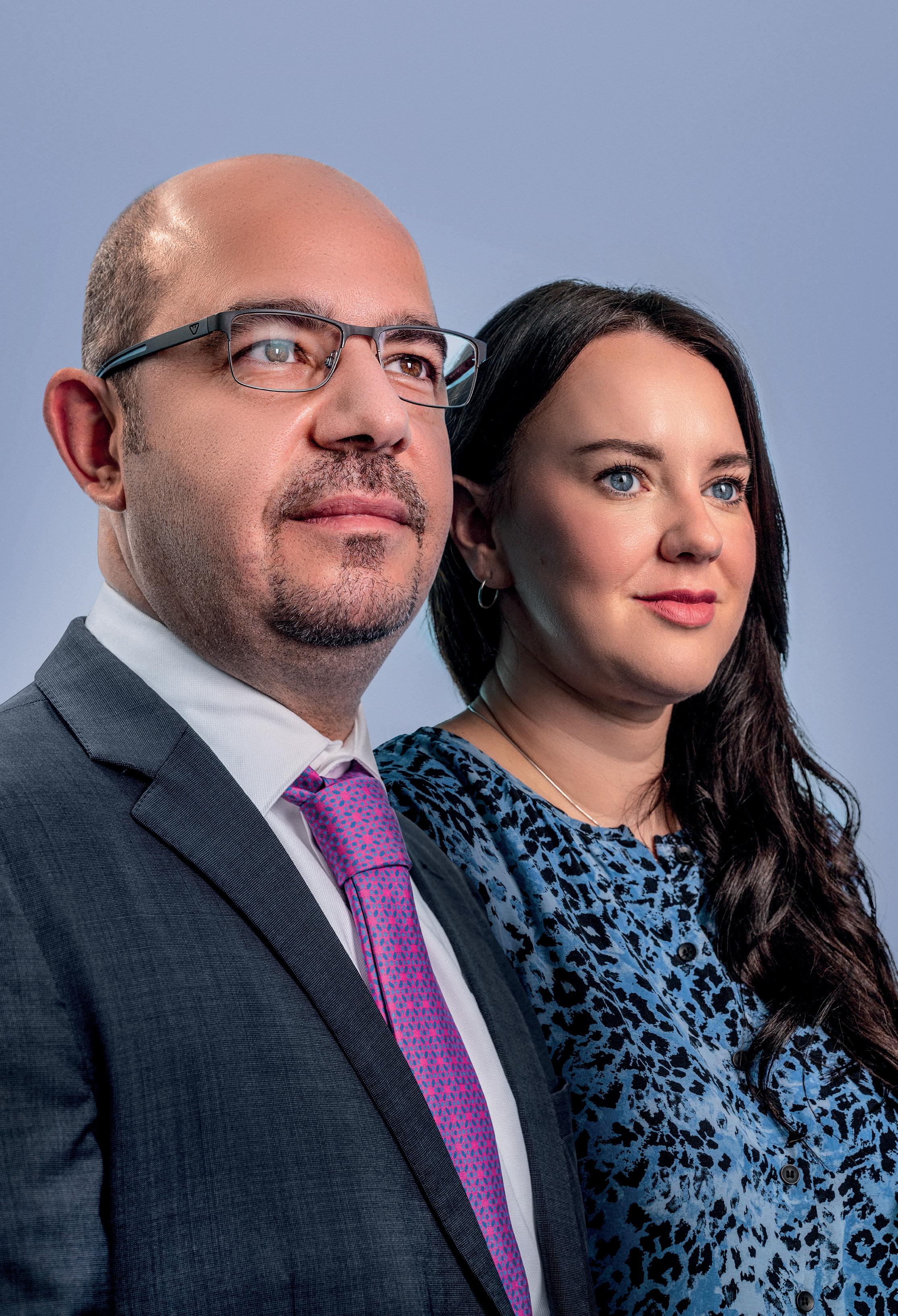

FOR THE CONSTRUCTION SPECIALIST Licensed by Dubai Development Authority 104 JULY-AUGUST 2023 SUSTAINABLE Engi Jaber and her lifetime quest SECURE Port53 and leadingedge cyber security The Experts Nawfal Al Khudhairy and Sarah Saxon at Compass Project Consulting C-SUITE The conclusion of our exclusive economic dialogue


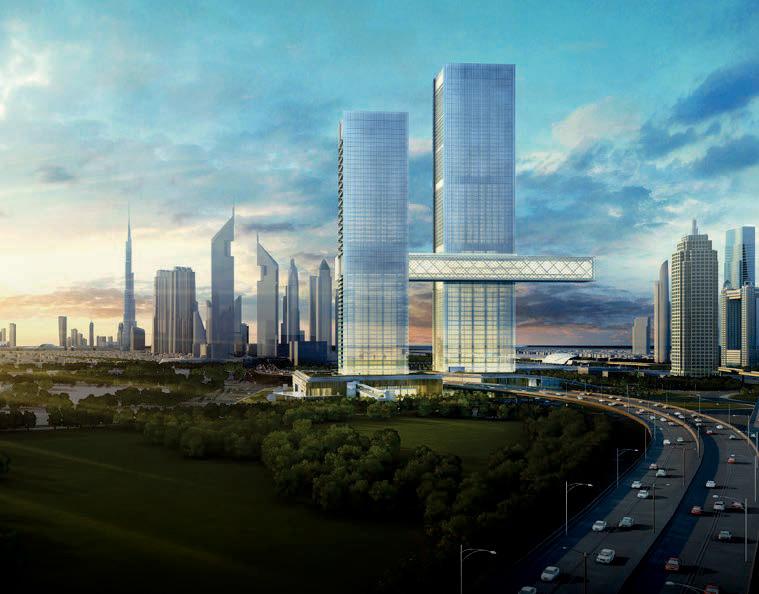









2015, 2016, 2018, 2019, 2020, 2021 & 2022 COST CONSULTING COMPANY OF THE YEAR COMPANY OF THE YEAR 2021
July-August 2023 Issue 104
“A forwardthinking, thriving business”
Who better to talk to about organisational challenges and opportunities - particularly in the Saudi market - than one of the industry’s most highly respected innovators and champions? Middle East Consultant spoke in detail to Nawfal Al Khudhairy, President, Compass Project Consulting

Expert Opinion Behind closed doors at the C-Suite
Continuing our report on the region’s most compelling, insightful and super-valuable consultancy & geopolitical debate
In Practice
“A single source of truth”
At a time when factors like the quest for sustainability and the use of advanced design technology are paramount issues, how are multidisciplinary consultancies best responding? Middle East Consultant spoke to Nic Byczynski, Director of Sustainable Engineering, AESG…
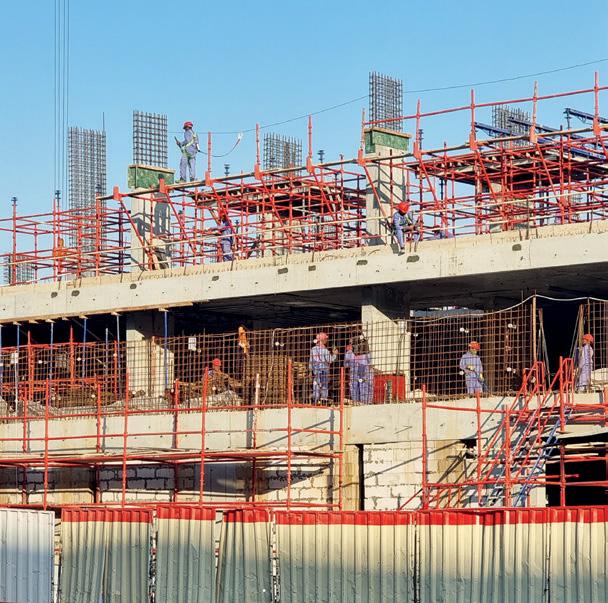

July-August 2023 meconstructionnews.com Contents | 01 Cover Story
08
24 19
Summit
What will the Future look like?
At the Habtoor Grand Resort on 14th June, the Future of Architecture Summit set out to answer some big, compelling questions - and had some surprising conclusions…

In Practice
The new era of AI-led generative software has already led to a number of alarm bells sounding when it comes to the working future of architects. Here, two senior figures from KEO International Consultants evaluate the changes and make some powerful future powerful predictions…

In Practice
Middle East Consultant spoke with Engi Jaber, CEO/Managing Director, Climatize Engineering Consultants, whose entire calling has revolved around a fascination with sustainable values


July-August 2023 meconstructionnews.com 02 | Contents
“I want to do it right”
32
“A more environmentallyresponsible world?”
48 28
Louise Collins, Head of Engineering & Energy MEA, and Head of Project & Development Services UAE, JLL, on implementing a net zero agenda...
42
Ÿ
Ÿ
Ÿ
Ÿ
Ÿ
Ÿ
Threat & Risk Assessment
Gap Analysis
Security System Design

IT/AV Design
Master Planning & Development
Operational Requirements
Ÿ
Ÿ
Ÿ
Ÿ
Ÿ
Ÿ
Testing & Commissioning
Control Room Design
System Integration
Policies & Procedures
Site Surveys & Audits
Crisis Management
In quest of ultimate Awards entries…
Let me be completely honest about this. With the Middle East Consultant Awards now live, and all set for a stunning gala award ceremony on 22nd November, my goal is to attract the strongest and most stunning entries the event has ever seen. Now, I certainly didn’t make many friends on-stage at last year’s event, when I commented that while entries in the ‘People’ categories were outstanding, those in the ‘Company’ and ‘Project’ sections tended to be somewhat predictable - even lacklustre. So this year, I’d like to see very high quality entries across the board, with some really exciting projects taking centre-stage.
In order to help companies show themselves at their very best, this year, we are allowing entrants to submit video entries for the first time (the details of the kind of format that companies can use are listed on the Awards website). I promised this when I was on-stage at the Awards gala last year, and now it’s actually happening. I expect to see this dramatically increase the number of entries to the Awards and also change the style
of entry, too. Of course, you can still apply the traditional way, using the nomination form, if you want to.
Nominations close on Friday, 27th October, and I’d like to share a couple of tips about what the Judges will be looking for. Overall, the best advice I can give is to ensure that you enclose not less than three client testimonials (signed and stamped) and really spend time thinking about why your nomination is the worthy winner. What truly makes it special and have you fully communicated this? Have you attached images that do it justice and have you told us anything of special interest that will stay in the Judges’ minds?
Then, when it comes to what not to do, firstly, please only enter projects that fall within the stipulated timeframe - if they don’t, they won’t be considered. The second biggest turnoff for the Judges is seeing an entry that’s only one page long and has clearly been submitted as an after-thought. This simply won’t get the job done. Apologies if that sounds somewhat complacent - it’s really not meant to be, it’s just part of the expectation that comes when I work with the fantastic and amazingly skilled businesses that this region boasts.
See you on-stage receiving an Award?
Group
MANAGING DIRECTOR
RAZ ISLAM raz.islam@cpitrademedia.com
+971 4 375 5471
MANAGING PARTNER
VIJAYA CHERIAN vijaya.cherian@cpitrademedia.com
+971 4 375 5713
DIRECTOR OF FINANCE & BUSINESS OPERATIONS
SHIYAS KAREEM shiyas.kareem@cpitrademedia.com
+971 4 375 5474
PUBLISHING DIRECTOR ANDY PITOIS andy.pitois@cpitrademedia.com
+971 4 375 5473
Editorial
EDITOR PAUL GODFREY paul.godfrey@cpitrademedia.com
+971 4 375 5470
Design

ART DIRECTOR SIMON COBON GRAPHIC DESIGNER
PERCIVAL MANALAYSAY
PHOTOGRAPHER MAKSYM PORIECHKIN
Circulation & Production
DATA & PRODUCTION MANAGER
PHINSON MATHEW GEORGE phinson.george@cpitrademedia.com
+971 4 375 5476
Marketing & Events
EVENTS EXECUTIVE MINARA SALAKHI minara.s@cpitrademedia.com
+971 4 433 2856
SOCIAL MEDIA EXECUTIVE
DARA RASHWAN dara.rashwan@cpitrademedia.com
Web Development
ABDUL BAEIS UMAIR KHAN
FOUNDER DOMINIC DE SOUSA (1959-2015)

July-August 2023 meconstructionnews.com
04 | Welcome
by The publisher of this magazine has made every effort to ensure the content is accurate on the date of publication. The opinions and views expressed in the articles do not necessarily reflect the publisher and editor. The published material, adverts, editorials and all other content are published in good faith. No part of this publication or any part of the contents thereof may be reproduced, stored or transmitted in any form without the permission of the publisher in writing. Publication licensed by Dubai Development Authority to CPI Trade Publishing FZ LLC. Printed by Al Salam Printing Press LLC. CPI Trade Media. PO Box 13700, Dubai, UAE. +971 4 375 5470 cpitrademedia.com © Copyright 2023. All rights reserved.
Published
Editor, Middle East Consultant

LATEST NEWS FEATURES

INDUSTRY
Dubai issues new law to regulate urban planning
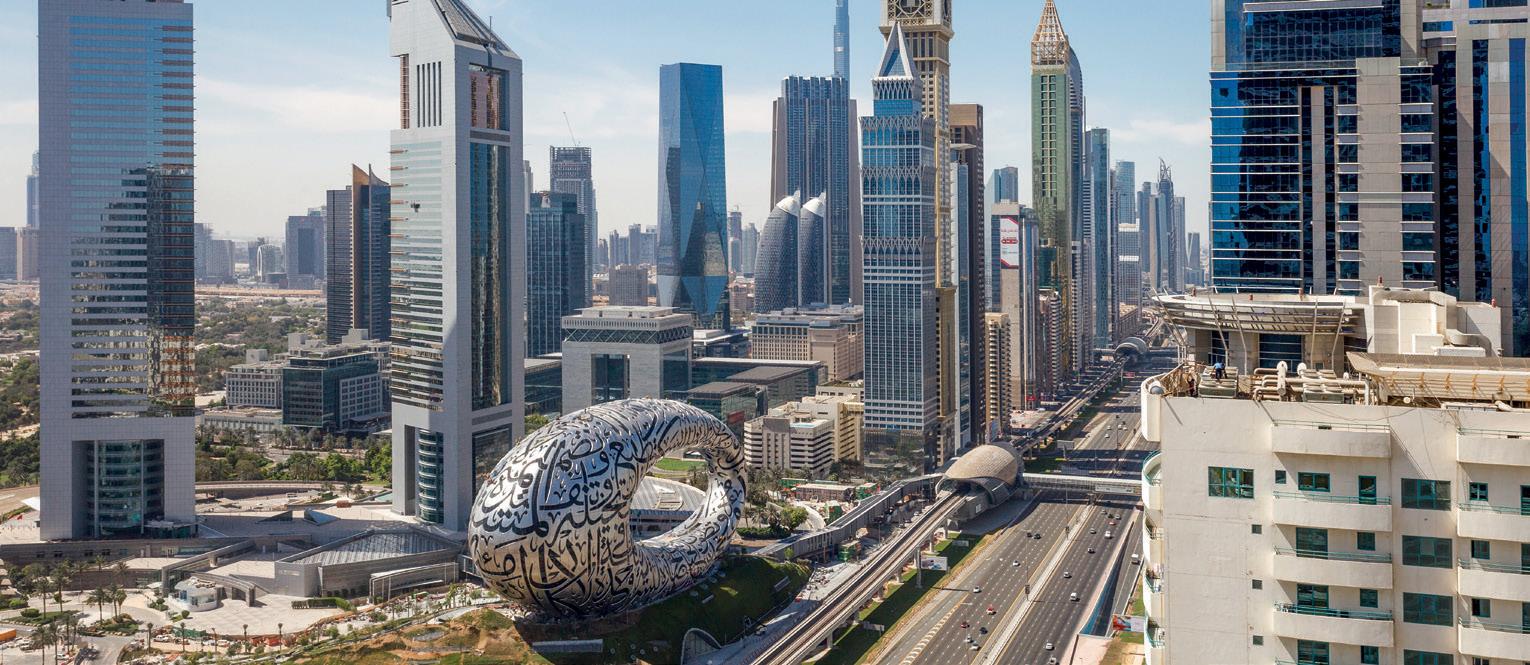

ANALYSIS: Indians invested US $4.32bn in property in Dubai in 2022

CONSTRUCTION
Azizi making strong progress on Creek Views II
SUSTAINABILITY
Toyota set to fund and operate Saudi solar plant


INTERVIEW: Advocating for Nature-Based Solutions to Address Water Security

CONSTRUCTION
3,200 land plots allocated to Emirati citizens

EXPERTS: Leading the charge on food waste solutions
INFRASTRUCTURE
Talks underway to finalise Bahrain/Saudi railway link

July-August 2023 meconstructionnews.com 06 | On Topic
REGISTER NOW 06 September 2023 Habtoor Grand Resort JBR
PROPERTY
New Palm Jebel Ali masterplan approved by Sheikh Mohammed Occupying an area twice the size of Palm Jumeirah, the Palm Jebel Ali will feature extensive green spaces and unique waterfront experiences
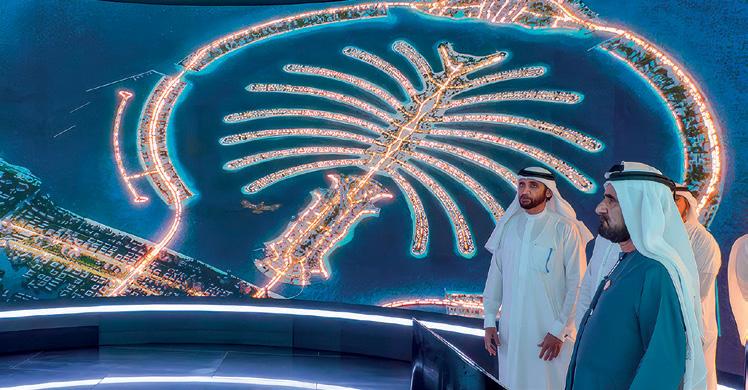
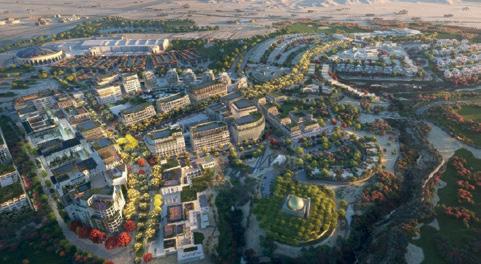
CONSTRUCTION
Al Maktoum Solar Park fifth phase launched When complete, the plant is expected to reduce 6.5 million tonnes of carbon emissions annually

INFRASTRUCTURE
RTA completes upgrade project and deploys 14,000 LED lights LED lights consume 60% less energy than traditional lights and offer increased lifespans by up to 177%
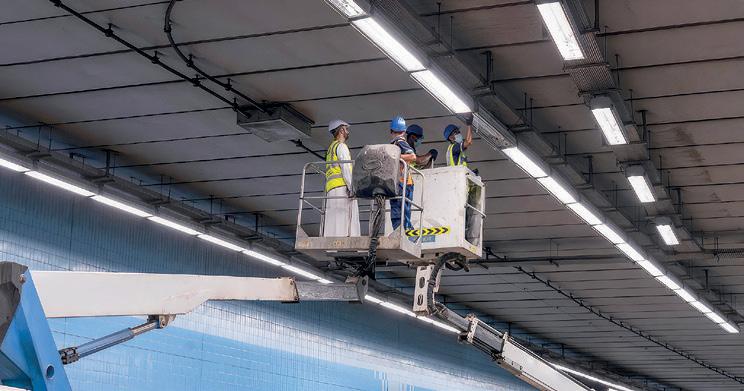
CONSTRUCTION
Al Habtoor Tower will “redefine the concepts of luxury and comfort” says Mohammed Al Habtoor
The 82-storey development features 18 high-speed elevators and is set to attract key investors

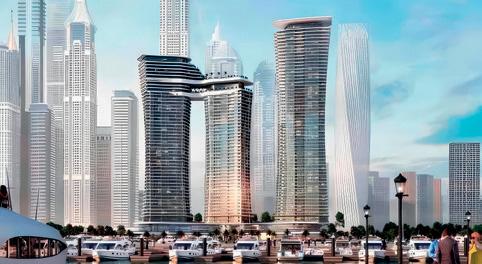

ENERGY
Posco-led consortium wins $6.7bn deal to build green hydrogen plant in Oman Consortium partners include Samsung Engineering, Engie and PTTEP and others



July-August 2023 meconstructionnews.com On Topic | 07
FEATURED NEWS
MOST POPULAR
PROPERTY Damac announces Golf Greens
CONSTRUCTION Sobha Realty pre-launches second SeaHaven tower
INFRASTRUCTURE
Mota-Engil wins US $920.05mn rail project contract in Nigeria
CONSTRUCTION Dubai Municipality sets up hiking tracks at Mushrif National Park
CONSTRUCTION Master consultant needed for Madinat Al Irfan East
REGISTER NOW 26 September 2023 Habtoor Grand Resort / Dubai
Cutting-edge technology is transforming the delivery and sustainable operation of regional megaprojects

meconstructionnews.com July-August 2023 08 | Close-up
n a recent Linkedin post, you said that:
“I believe that business development, marketing, and sales are inextricably linked as pillars of organisational triumphs’. What other factors do you see as most critical in today’s fastchanging market?
“In today's fast-changing market, I truly believe that organisational success relies on a combination of factors, beyond the core pillars of business development, marketing, and sales. It's crucial to consistently deliver exceptional services to build trust and loyalty among clients, and in turn, maintaining positive client relationships is key to fostering satisfaction and encouraging repeat business. By
exceeding client expectations, we can forge long-lasting partnerships that thrive in a competitive landscape.
“Additionally, investing in the development of local talent not only empowers young Saudis but also positions them at the forefront of account and client management. We recognise the importance of building a robust knowledge repository to enable continuous learning and offer innovative solutions to our clients. Lastly, identifying and leveraging sources of competitive advantage allows us to stand out and make a lasting impact in the market.”
In an era when we’re seeing the rapid growth of multi-disciplinary engineering firms, absorbing the skills of project managers and architects alike, what do you see as the greatest challenges to Compass and its progress?
“In the face of rapid growth and intense competition, addressing these crucial challenges is essential for maintaining our success and prominence in the industry.
“Firstly, understanding our competition is vital. By closely examining their strategies, strengths, and weaknesses, we can identify opportunities to differentiate ourselves effectively, and through understanding what sets us apart and highlighting our unique value proposition, we establish a distinct position in the market.
“Another important aspect is building and preserving relationships. Strong connections with clients, partners, and stakeholders are the foundation of our success. Nurturing these relationships through open communication, delivering on promises, and providing exceptional service will bolster our reputation and secure continued partnerships.
“Furthermore, staying attuned to the ever-changing market demands is essential. We must continuously monitor industry trends, technological advancements, and shifting customer preferences to ensure our offerings remain relevant and competitive. Adapting swiftly to market dynamics help us stay ahead and meet evolving client needs.
“Lastly, as Compass progresses, we must remain true to our company DNA. Upholding our core values, culture, and identity is essential to preserving the essence that has made us successful. As we grow and expand, staying anchored to our roots will guide our decisions and reinforce the trust our clients have in us.”
Tell us something about Compass’ commitment to Saudisation and how successfully it is positioning young Saudis at the forefront of account and client management?
“Compass demonstrates a strong commitment to Saudisation, successfully positioning young Saudis at the forefront of account and client management through various initiatives. We maintain a minimum percentage as a key performance

July-August 2023 meconstructionnews.com Close-up | 09
Who better to talk to about organisational challenges and opportunities - particularly in the Saudi market - than one of the industry’s most highly respected innovators and champions? Middle East Consultant spoke in detail to Nawfal Al Khudhairy, President, Compass Project Consulting
“A forwardthinking, thriving business”
Nawfal Al Khudhairy, President, Compass Project Consulting.
indicator (KPI) for all business leads at different levels, ensuring continuous growth opportunities for Saudi talent. Engaging in training and mentoring programmes allows us to nurture their skills and expertise further. Our Saudi future leaders' programmes offer a clear path for career progression, empowering young Saudis to take on leadership roles. Additionally, our women empowerment programmes promote gender diversity and provide equal opportunities for growth and success within the organisation. Through these efforts, Compass continues to elevate young Saudi professionals to prominent positions, contributing to their career development and the overall success of the company.”
Where do you see the future key areas for development in the Saudi market: will you be looking for more engagement in the giga-projects or will you be looking for the next generation of ‘stand-alone’ initiatives?
“In the future, we envision key areas for development in the Saudi market encompassing a combination of standalone initiatives and engagement in gigaprojects. We believe that pursuing standalone initiatives with new innovations will be crucial for driving progress and creating impactful solutions. Simultaneously, we recognise the immense potential of giga-projects and the opportunities they present. By incorporating technologies such as IoT (Internet of Things) and AI (Artificial Intelligence) into giga-projects, we can enhance efficiency, optimise processes, and deliver exceptional outcomes. Moreover, our focus extends to innovation in smart and technological systems, as we strive to leverage cuttingedge solutions to improve project performance and maximise benefits. By combining stand-alone initiatives, technological advancements, and strategic engagement in giga-projects, Compass aims to contribute significantly to the development and transformation of the Saudi market.”
What do you perceive to be the real USPs of Compass and its capabilities?
“The true unique selling propositions (USPs) of Compass lie in our agility and robust capabilities in project, commercial and cost management. Our agility allows us to adapt swiftly to dynamic market demands and deliver tailored solutions efficiently. With a focus on strong commercial management, we ensure optimal financial performance and cost-effective project execution, fostering lasting client satisfaction. Our prowess in project management ensures seamless coordination, timely delivery, and successful outcomes, establishing Compass as a reliable and trusted partner in the industry.
“Having said that, the real USPs of Compass extend beyond agility and strong project management to demonstrate our exceptional talent and seasoned expertise.

July-August 2023 meconstructionnews.com
10 | Close-up
As Compass progresses, we must remain true to our company DNA. Upholding our core values is essential to preserving the essence that has made us successful. As we grow, staying anchored to our roots will guide our decisions and reinforce the trust our clients have in us”
Our team comprises industry experts with a wealth of experience, bringing diverse perspectives to every project. With their specialised skills and knowledge, they navigate complex challenges with ease, ensuring unparalleled project delivery.

“Our seasoned expertise empowers us to provide innovative solutions and strategic insights, elevating our services to the highest standards. Clients value our ability to anticipate and address potential issues proactively, maximising project efficiency and minimising risks. As a result, Compass has built a reputation for excellence, garnering trust from clients who rely on our agility, top-tier talent and seasoned expertise to drive their projects to success.”
Is there a dominant style of project that you see emerging in the Compass portfolio?
“In the Compass portfolio, we witness a notable emergence of diverse project styles that set us apart in the industry. Fast-track projects present us with unique challenges that we embrace as opportunities to showcase our expertise and efficiency, differentiating us from competitors. Moreover, we excel in handling various asset classes, especially in mixed-use and entertainment developments, where we have proven our versatility and capability to create exceptional spaces that cater to different needs. Additionally, we are experiencing a growing requirement within the development of sports cities and stadiums.
To what extent do you see yourselves as a ‘people-first’ business, and a champion in the War for Talent?
“We wholeheartedly see ourselves as a 'people-first' business, making us a true champion in the War for Talent. Our unwavering commitment to talent is evident through our full focus on nurturing and empowering our workforce. We recognise the value of each individual, which is why we have separate development programmes tailored for everyone's growth and success. Through career path mapping, we provide a clear roadmap for advancement, ensuring that every team member has the opportunity to flourish and reach their full potential within the organisation. By prioritising our people, investing in their growth, and fostering a supportive work environment, we continuously attract and retain top talent, propelling Compass to the forefront of the industry and solidifying our reputation as a destination of choice for aspiring professionals.”
What do you see as the major risks and challenges confronting businesses like yourselves in the current climate? How will you best navigate these?
“In the current climate, businesses like ours face significant risks and challenges. To navigate effectively, we will strike a balance between mega PMC remits, alongside preserving our identity. Enforcing processes, managing the supply chain, and addressing talent shortages are priorities. Additionally, we will foster transparent stakeholder communication to ensure mutual understanding and support. Proactive measures will drive our success, fostering resilience and positioning us as a forward-thinking and thriving business.”
Tell us a little more about yourself, your background - and your vision for Compass’ development in the next five years and beyond?
“I've had the privilege of gaining extensive international and local experience, which has allowed me to bridge cultural gaps in multi-disciplinary businesses effectively. My strengths lie in open communication, negotiation, and creative problem-solving.
As a results-driven strategist, I love the challenge of identifying and developing new products, bids, tenders, service portfolios, and marketing strategies that make a difference.
“What truly excites me is leading and supporting teams to achieve greatness. I've honed my leadership and management skills over the years, navigating change, turnarounds, and mergers in an everchanging market. This journey has not only built a flawless reputation for me but also strengthened my client relationships through clear communication and a focus on teamwork.
“As for my vision for Compass, I see us becoming a unique, leading name both regionally and internationally. We'll expand our horizons, spearheading major projects that align with Vision 2030. Staying true to our commitment to excellence and innovation, we'll continue to grow as a tier one localisation company. Together, we'll elevate Compass to new heights, making our mark as trailblazers in the industry and creating a positive impact on the world we build.”

July-August 2023 meconstructionnews.com Close-up | 11
One of the key factors, says Nawfal, is always maintaining transparency with key stakeholders and sustaining a forward-thinking approach.


Raising the bar and encouraging true competitive advantage Get in touch Contact us Wednesday 22nd November 2023 THE RITZ CARLTON JBR / DUBAI / UAE Content Paul Godfrey +971 55 472 9717 paul.godfrey@cpitrademedia.com Sponsorship Andy Pitois +971 4 375 5473 andy.pitois@cpitrademedia.com

meconsultantawards.com © 2023 CPI Trade Media. All rights reserved. PRESENTEDBY PRESENTED BY SUPPORTING PARTNER SILVER SPONSOR SILVER SPONSOR PRESENTED BY Scan here Nominate now 2023 Event Partners Nominations are now open
Sarah Saxon, Regional Head of Human Capital, Compass Project Consulting.
replicate the existing bias, because they will then ensure that the company will continue to ‘do more of the same’. But we do it the other way round! We pick the right people and let their empowerment drive the business.
“Remember, ‘groupthink’ can be very dangerous - you’ll get the same answers to the same problems and the same decisionmaking. In summary, you won’t get any innovation.”
ompass has become a leader in its commitment to ED&I - but how do you see these principles actually contributing to company performance?
“For a start it expands our talent pool. We pride ourselves on supplying the best talent in the market to our clients. This has been one of the pillars of our performance and success. This is our ‘guiding north star’, so we have an inside mentality to focus on looking for talent, not for the faces that fit. Our gender split is healthy, and we employ more than 37 nationalities (and counting!) and every one of our people has the chance to participate, influence and involve themselves in the way we serve the market. We start with success and performance in mind at the beginning and that is what we have as an outcome. In fact, this is one of the only companies I have worked in where I haven’t felt a real divide between men and women.
“Also, I should add that my philosophy is ‘people over profit’: many surveys show that diversity adds to the bottom line - but I let the business look after that. What concerns me is that it’s fundamentally and ethically right to commit to diversity; plus, the reality is that when you bring on board female team members and a range of ethnicities, you will be making a powerful sea-change in the business’ culture. Compass asks ‘where is the talent?’ - and this is what we then bring to the market.
“One of the risks for many businesses is that they bring in individuals who will
What do you believe are the most significant issues in today’s ‘War for Talent’ and how do these impact Compass and its priorities?
“The biggest issue that businesses face is being agile and flexible enough to provide what the employee market wants when it wants it. Agility is part of our core values, so we are actively shifting to ensure we are well positioned to meet the current demands of the market. There are 3 significant factors that will build our ability to navigate the war on talent:
1. Flexibility
2. Talent Development
3. Effective compensation and benefits
“We have amplified these within our people strategy this year and are actively pursuing enhancements to ensure we retain and look after our talented people.”
Does Compass exemplify a policy of ‘equal pay for equal work’ when it comes to employment across ethnic groups? (For so long a troubling issue in this region…).
“Yes, we do. And it’s something I have recently audited. The challenge every business faces however is the skill sets at different levels. We can still see certain trends at a leadership level, but in Compass, it’s amazing to see that a good representation of our management comes from groups that are typically under-represented. They are rewarded fairly and do an excellent job for us. 80% of our values champions who were recently recognised and rewarded were also from typically under-represented groups. Our
meconstructionnews.com July-August 2023
14 | Close-up
At a time when key factors like the rise of AI, sustainability and The War for Talent are changing business practices at a relentless pace, how should an organisation identify and pick the right talent? Middle East Consultant spoke to Sarah Saxon, Regional Head of Human Capital, Compass Project Consulting…
“A culture that people want to work in”

July-August 2023 meconstructionnews.com Close-up | 15
people are our backbone, and we treat them as such.
“It’s also vital, though, not to think in terms of a one-size-fits-all, blanket solution. Instead, it’s really about catering to individual needs and achieving equity of opportunity. Here, we focus on the level of talent and that results from asking core questions like: ‘what do we need?’ Then, we go about finding those individuals, wherever they are from.
“It’s also the case that there are so many contextual complexities that come into play. For example, we see all the time that people from diverse cultures and backgrounds can have the right talent in abundance, but they won’t always have the same confidence - they will need training in leadership skills, and this is something that we are very keen (and also very wellequipped) - to provide.”
What do you believe are the most significant HR challenges for a fastevolving business such as Compass?
“Right now, it’s sourcing talent. Because this underpins our success, it is critical we attract people who can provide the best service to our clients. But as growth trajectory increases speed, we want to provide a quality service to our people and, unfortunately, the evolution of this takes time. It doesn’t happen overnight. The other challenge in HR is that it’s always a grey area. When you work in an industry that’s black and white (i.e., there’s a right way to build something and there’s a wrong way to build something), HR can be a precarious area because we don’t have a universal solution to all scenarios. Everyone has different needs and wants, and one cannot afford to be fast and sloppy with an off-the-peg strategy that you hope will work for everyone. It won’t.”
What do you see as the key role(s) of Leadership in today’s competitive marketplace - and how do you tackle these?
“The key role for leadership is to be a servant of the people. It’s about
recognising and removing one’s ego, being fully self-aware of who you are and how your behaviors trickle into the business and what effect they have. We have implemented executive coaching in our C-suite and, as an accredited Coach, I also provide coaching to directors to help them navigate their people’s decisions so that we achieve the best outcomes together.
“I would also add that the face of a business isn’t ever built by one person - a company is built by many faces and many people. Clever leaders will engage the strength of individual people who demonstrate the right and most appropriate talents. If a leader is a strategist, for example, they will always need to work with someone who is an executionist, who can deliver on the fine print of that strategic vision and make sure it’s grounded and actually getting done.
“Also, while a leader has to have a clear vision, it’s not enough just to have that vision, it also needs to be articulated - with crystal-clarity - to the rest of the business. This is where a lot of leaders fall down. You’ve got to give people purpose, and you do this by communicating a clear vision
with passion. Plus, as a leader, you need to have a deep, deep level of self-awareness. The more self-aware a leader is, the more they will be able to adjust their decisions and make wiser choices for the benefit of the people in the business.”
In terms of Change Management, how do you see Compass as having changed and where do you understand it to be ‘morphing’ to in the pursuit of future goals? How will you re-equip it

July-August 2023 meconstructionnews.com
16 | Close-up
HR can be a precarious area because we don’t have a universal solution to all scenarios. Everyone has different needs and wants, and one cannot afford to be fast and sloppy with an off-the-peg strategy that you hope will work for everyone. It won’t”
for that journey?
“Compass has had a clear vision since the beginning and has tirelessly pursued that. We are still working towards this vision, as new areas and investments open up. In order to equip the business for that journey, we have recently re-evaluated and relaunched new business values to reflect the behaviours we hold dear, so that they guide everything we do. They reflect the behaviours that have contributed to past success and will continue to drive that over the next decade.”
Is there a comprehensive Wellness programme in place for all staff, and if so, what are its key features? Is buy-in to this programme compulsory?


“We do. We provide our people with a premium wellness package that holds
monthly checks, webinars and challenges to support their wellbeing, but I acknowledge it’s still not enough. The expansion of wellness is top of our people agenda for 2024. I recently attended a fireside session with Mo Jawdat and what I took away on wellness was mind-blowing. I will also add the following, as it’s a favourite quote I picked up last year from a Professor of Economics: “In the past, jobs were about muscle, now they’re about brains, but in the future, they’ll be about heart.”
“This should be the biggest sign to us all that wellness isn’t a buzzword, nor is it just a checkbox for HR only. Every leader needs to be conversant in this.”
Do you believe it’s important to create a truly consistent ‘transnational’ corporate culture, or should it be localised and different for each community?
“I believe it’s important to build a culture that people want to work in, regardless of where that’s based. We can argue the merits of each all day long but what matters is what’s the best fit for the people so they can perform and go home to their families happy.”
Tell us something about yourself - what aspects of the Leadership/Human Capital paradigm do you feel most passionately about?
I am very passionate about coaching and helping people overcome their own mental barriers. I’ve coached hundreds of people and I know that what blocks people from achieving what they want is often just their point of view. It gives me a ton of joy to help them break through this and start living a life that feels good. From a leadership perspective, I am passionate about helping leaders see where their ego is affecting their performance and ability to build great teams. It’s also satisfying to see them have breakthroughs and change their approach with people. My golden rule in leadership is this: If you want to change something, you need to change something about yourself first.”
July-August 2023 meconstructionnews.com Close-up | 17
One of the key factors, explains Sarah, is creating a culture that empathises with local value-sets and knows how to empower and develop leadership wherever it is best found.

© 2023 CPI Trade Media. All rights reserved. Content Jason Saundalkar +971 4 375 5475 jason.s@cpitrademedia.com Sponsorship Raz Islam +971 50 451 8213 raz.islam@cpitrademedia.com Sponsorship Madeleine Martin +971 58 536 1208 madeleine.martin@cpitrademedia.com Complimentary Register Now Register for free and stay connected Wednesday 6th September 2023 Ensuring regional water security through governance, sustainability and best practice HABTOOR GRAND RESORT JBR / DUBAI / UAE BRONZE SPONSOR PRESENTED BY PRESENTED BY PRESENTED BY BRONZE SPONSOR SUPPORTING PARTNER ENDORSED BY fowsummit.com


July-August 2023 meconstructionnews.com BEHIND CLOSED DOORS AT
C-SUITE
BY PRESENTED BY ME Consultant CPI Trade Media CO NFIDENT I A L –OD N TO RTSID I B UTE –CLASSIFIED CONTINUING OUR REPORT ON THE REGION’S MOST COMPELLING, INSIGHTFUL AND SUPER-VALUABLE CONSULTANCY & GEOPOLITICAL DEBATE
THE
ORGANISED
ust to recap: in the May issue of Middle East Consultant, we featured the first glimpse of the provocative dialogue generated at the C-Suite - a ‘behindclosed-doors’ event that took place on 14th March 2023, where six top executives from the fields of consultancy, project management, architecture & design, dispute resolution and law, met in the The Capital Club, DIFC.

For three hours, they discussed key issues relating to the construction and development market, tackling fundamental issues such as the economy, rising costs, recruitment, Saudi’s giga-projects, payment issues and price-driven markets,
THE TABLE CAPTAINS
SPENCER


WYLIE, CHIEF EXECUTIVE OFFICER, COMPASS PROJECT CONSULTING
and the impact of war in eastern Europe.
The event - termed the C-Suitefollowed an amended version of the Chatham House Rule. This means that while this Report can comprehensively cover what was said, when it comes to who said what, comments cannot be attributed and remain fully confidential. Thus, with the promise of confidentiality, the panelists - whom we term ‘Table Captains’ - could fully express their views in a fully-informed and heartfelt way. This often led to astonishingly frank moments in the discussion and a set of insights and observations that are not only ground-breaking, but are critical reading for every construction and development professional.
Here, we are delighted to feature the next four conversations that took place at that fated event; we are sure you will find them stimulating, disarming - and also, dare we say, quite stunned by how they signpost a number of commercial and geopolitical ‘red flags’…
JAD CHOUMAN, PARTNER, HEAD OF MIDDLE EAST, HKA
DIALOGUE 2 - DO RISING PRICES AND GEOPOLITICS LEAD TO MORE ADVERSARIAL BEHAVIOUR?
The consensus was that adversarial behaviour isn’t necessarily linked to geopolitics or economic issues - rather, it’s simply endemic in the industry! It’s just - as the panelists described it - ‘oldfashioned bad stuff’.
There was indeed a fall-off in disputes when the war in eastern Europe first broke out, while companies took stock of what it might mean for them. Yet after a few months, the level of disputes went back to normal.
However, there are other factors that do lead to higher levels of adversarial conduct. For example, another aspect of the rising costs that we are seeing is thatincreasingly - developers fund themselves through the aggressive and deliberate nonpayment of their supply chain, thereby
SACHIN KERUR, HEAD OF MIDDLE EAST REGION, REED SMITH
ADAM SMITH, MANAGING DIRECTOR, POLYPIPE MIDDLE EAST
AMMAR AL ASSAM, CHIEF EXECUTIVE OFFICER, DEWAN ARCHITECTS + ENGINEERS
PAUL GODFREY, EDITOR & MODERATOR, ME CONSULTANT
VENKATESAN SETHURAMAN, EXECUTIVE VICE PRESIDENT, DANUBE GROUP
meconstructionnews.com July-August 2023
20 | Expert Opinion
Does Quality matter?

seeking to improve levels of liquidity that might otherwise be rapidly compromised. Do their suppliers retaliate and try to get their dues? Interestingly, those smaller, downstream, companies are less inclined to ‘keep the gloves on’ once they are working on major projects in Saudi Arabia. Fuelled by new levels of income, if they have payment issues with the ‘magic circle’ developers here in the UAE, they are hesitating much less to take them on head-to-head with litigation. The UAE’s four ‘magic circle’ developers were once seen as de facto out of reach of litigation from smaller businesses, but that picture is changing.
DIALOGUE 3ARE PEOPLE STILL PREPARED TO PAY FOR QUALITY?

The answer is ‘No’. In fact, almost the reverse seems to be the case. Increasingly, major-name clients are seeking to appoint high-quality, successful businesses because they feel that they can handle prolonged periods of non-payment!
The feeling among panelists was that the ‘magic circle’ developers are no longer interested in long-term value and will not pay the premium prices asked by leading international brands. This is now leading to the rise of the niche, boutique providers. The medium, ‘Grade B’ and ‘Grade C’ contractors now have a golden opportunity - but they risk having more work than they can handle! Their revenue may well be pushed from $500m per year to $2-2bn, but it’s near-impossible to find the resources to service this dramatic increase in a proper and professional way. We are seeing the ‘supercharging’ of these mid-grade contractors particularly in Saudi Arabia, where there has been a perennial challenge to attract the acknowledged industry champions from the USA and western Europe for example,
Of course, when we talk about ‘quality’, it is a very subjective term. But what we can talk about instead is the practice of
following the required ISO and regulatory standards. Within the GCC, however, there has often been a view that these represent ‘Rolls-Royce’ standards, when in fact, they are the lowest acceptable standards to follow and deploy. It should, of course, be the case that when you are dealing with ‘critical to life’ systems, there is no difference between the Royal Atlantis and a suite of labourers’ accommodation - both should universally use elements meeting the necessary agreed ISO protocols. Again, however, we can’t rely on this, and the ISOgraded components may simply be valueengineered away as being over-costly or - even worse - surplus to requirements.
There was consensus around the table that one of the primary causes for this laxity is the region’s obsession with speed. It was felt that this is primarily why, when dealing with supply chain and procurement issues, the GCC behaves very

differently from many other parts of the world. So, while global supply chain best practice suggests it’s not the ‘what’ that’s important, but the ‘why’, in this region, noone starts with ‘why’.
Another consequence of this fondness for speed is the reliance on an ‘Open Vendor’ list. The panelists observed how it would be unthinkable to find such a hitand-miss, unqualified practice in industries like aviation and pharmaceuticals: yet, here in the Construction sector, it’s an accepted and dangerous norm.
Similarly, there are countless instances of major projects already getting underway before the design stage has been finalised - with work-in-progress constantly being interrupted and re-directed ‘on the go’. This again is because of the dominating preference for speed and the fear of holding things back for a second in order to take stock of where the real priorities lie.
July-August 2023 meconstructionnews.com
Three of the six panelists believed that their companies had failed utterly to attract GenZ employees - and that they currently had no idea how to do so.
One of the ongoing challenges with this core recruitment issue is that it’s increasingly the case that the resource pool is from a totally different generation to the people leading the projects. In this context, effective leadership can be nighon impossible. While this is - under any circumstances - a shocking state of affairs, it’s made exponentially worse by the sheer scale and complexity of many of today’s multi-stakeholder projects, which of course cry out for strong, focused leadership.

The truisms so often quoted about GenZ employees hold good: GenZ recruits have totally different work criteria from older generations and they want and desire very different things from life. They also don’t see continuity and long-service histories as business priorities.
Yet - there is some incredible talent out there, and this can involve new, revolutionary ways of working that conservative and tradition-bound leaders dismiss at their peril. For example, GenZ staff can often use technology to save huge amounts of time, and this can mean much less time spent on data acquisition, far more time spent on data analysis. A tradeoff no-one would want to ignore.
There was still consensus, though, that GenZ employees often want to run too fast. They need to spend more time learning the basics, putting in the hours and not being averse to the sheer hard slog of ‘learning the trade’.
One of the factors undermining GenZ recruitment is the increasing role of technology and the ease of working away from the office. It’s very difficult to convince GenZ staff to come in to the office - but this means they are missing out on so many of the cultural, interactive
skills gained from being part of the regular workplace environment. Can working on Teams calls and all that on-screen time, for example, teach you ‘how to read a room’?
Countless surveys also show that attrition rates are far lower when people are working in the office, rather than remotely, where there appears to be very little ‘glue’ cementing them to the organisation and its value-sets.

There is another aspect, too: the growing role of technology means that GenZ candidates will generally have little or no idea of aspects such as ‘relationship selling’, where the buying decision has been made because the salesperson appears to understand our wants and needs, and can tailor a bespoke product offer for us. In fact, that concept may scarcely even exist amongst this generation, where purchase is indirect, impersonal and done with a couple of clicks, not a dialogue or a showroom conversation.

The panelists believe that today’s leaders urgently have to resolve these issues and do a good deal of soul-searching. They also made the compelling point that if you have a ‘diverse and inclusive’ culture, the GenZ issue is simply one amongst many others; it’s just an extra consideration of modern business culture. Any business has to focus on attracting talent, regardless of age, gender, nationality and so on - it doesn’t have a choice. Plus, the reality is, it’s impossible to win the ‘War for Talent’ if we’re ignoring GenZ. However, when asked ‘how do you get GenZ staff into your business?’, the panel answered as one: “We’re not!”
There are also a host of recruitment issues around the Saudi giga-projects. One of the most telling factors is that a number of the Saudi clients will not only poach the staff from the consultancies servicing their projects, but will actually have their right to do inscribed in the project contract itself, eg, “After working together for 12 months, we can select your best people, with the option for them to work as our direct employees”.
Of course, aspects like this can make it extremely difficult to sustain a highquality of service: one of the panelists observed, for example, that after his top account director had been poached by the client, his business was then criticised for a fall-off in quality provision!

The reality is, that with the giga-projects, there is a real danger of the consultant simply being degraded to the role of a recruitment consultant for the client, and this is increasingly fostering ill-feeling. Moreover, Saudi clients are often totally outgunning the consultants in terms of sheer numbers at crucial meetings: another panelist observed that when he brought two staff members to a meeting, the Saudi client brought 17! Nor was this just an occasional event.
Alarming aspects like this are symptoms of much larger problems around the giga-


meconstructionnews.com July-August 2023 22 | Expert Opinion
DIALOGUE 5BEHAVIOUR, RESPONSIBILITY AND THE SAUDI GIGA-PROJECTS GenZemployable? CO NFIDENT I A L –OD N TO RTSID I B UTE –
DIALOGUE 4THE TOTAL FAILURE TO CAPITALISE ON GENERATION Z
projects. In fact, so many of the established ‘right’ ways of working aren’t being followed, that it begs the question: are these projects ever intended to be finished?
The panelists believed that indeed, not all of them are intended to be finished; there is a strong element of PR for the Saudi government at stake, and what matters more is their sheer existence, rather than the practicalities of their ever being completed. The pure supply chain mathematics show that there is actually no real chance of these projects ever being able to be finished: not only are there not enough resources in the GCC, but there aren’t enough resources available globally, either! The magnitude of this shortfall is such that it’s virtually impossible to imagine that many of these projects will actually be finished by 2030, the agreed ‘end-game’ to fulfil the KSA Vision.
Moreover, there was a round-table agreement that, if you were to make a list of all the things that you shouldn’t ever do with project management, many of the giga-projects do all of them - ticking all the wrong boxes time and again. But does it matter when there is so much income and prestige work at stake? Plus, it’s not

only the responsibility of the Saudi clients themselves: in many cases, there are highpowered western consultants working as freelancers and doing their best to obfuscate the realities in order to make the best living possible - even though they know, better than anyone, exactly what is going wrong.
Another reality is that while for most projects internationally, there are substantive supply-and-demand dynamics, where is the demand to fill the giga-projects? Most of the mega-communities that are being built are - surely - never going to make any money, and by the day, week, month and year are piling up incredible costs.
All of which is contributing to the problems that Saudi has in attracting the international key development champions (as mentioned above), and their increasing reliance on second and third-tier firms from Korea and China - many of which simply have little or no track record with projects of this scale and with such complex, multi-stakeholder profiles. Notwithstanding, there are schools of thought that believe this is another symptom of growing Chinese influence in the region. Indeed, if a giga-project ultimately lags behind its completion schedule, could
the entire project simply be handed over to China as a ‘little China’ enclave?
To be fair, though, from the perspective of the Saudi authorities, one of their biggest obstacles to completion is the fact that the supply chain in the GCC is notoriously low-tech: it is estimated that the level of innovation on-site, for example, is less than 5%. So it becomes almost a contradiction in terms when you have the ambition to deliver a fast-track project, but you only have a slowtrack process to work with.
In spite of this, there is one way in which the giga-projects truly lead the world, both in theory and in terms of their RFP content: Saudi clients have the vision to ask ‘what will the world look like in the future?’ This is a courage that, currently, we don’t see anywhere else on the globe, and we would do well to remember that 10 years ago, KSA was literally a blank canvass - and now, Saudi Vision 2030 is the biggest thing that’s ever been attempted in world history.

This ultimately poses contractors and consultants an intriguing - and hugely risky - question: which side will you be on? The supply chain? Or the Public Investment Fund?
The choice, according to the C-Suite, is yours…



meconstructionnews.com July-August 2023 Expert Opinion | 23
think it’s important”, says Nic, “to set the scene here by saying that at AESG, we were quite an early mover in the shift towards a ‘net zero focus’ and what it involves in terms of commitment to a recognised international agenda. In 2019, we made a commitment to the World Green Building Council, becoming a signatory of their charter and its sustainability mandate. Then in fact in 2023, AESG deepened its commitment to Middle East Net Zero goals by extending our partnership with the World Green Building Council as MENA regional partner, offering our expertise to help shape key green
building programmes and initiatives undertaken by the Council. So, while it’s only now that we’re seeing the whole sustainability dialogue really catching the public’s attention, in reality, as a business, we wanted to develop the dialogues around this two or three years ago and since then, it has been a driving motivation for us.
“I think this kind of background is important, because when we have clients who really want to make sustainability a priority, we need to advise them of the options and responsibilities that the road to net zero can entail. For example, LEED certification involves making a series of choices - it’s not an absolute set of standards - and you can have a good deal of leeway in picking your preferred route. But again, how should you do this and what will be the most practical and affordable options for you?
“Something that many companies don’t realise is that there are four principle elements in the net zero remit: Energy, Carbon, Waste, and Water. Most people
Digital design can benefit any aspect of MEP, integrating a comprehensive framework and enabling the highperformance developments.
are talking about Energy and/or Carbon - but even these are very different things. We are helping businesses make the right commitments - helping them understand that what’s being committed to is a journey, and there are a number of different (and potentially equally productive) routes that can be taken. Moreover, before you set out on that journey, you have to look at your timeline as a business: do you want to do this over one year, two years or 10? Those choices will make very different demands on your resources, deliverables - and of course, your costs.
“Another aspect that’s critical here is our belief in providing a true ‘top-down’ consultancy model. We can work at the very top of a business, speaking directly to the C-Suite. Then from here, we can start working our way down through the value chain. So, a company has its boardroom mission for its stakeholders, then its corporate policies, and then you have the specific guidelines for each vertical, whether it’s the hospitality division, real estate, public works, and so on. But if the sustainability goals and mechanisms aren’t consistent - and actually applied - all the way from the top down to the realities of life on the ground, then of course, they’re not worth having.
“In the UK, for example, they talk about the Golden Thread – in relation to tracking of Life Safety information and that idea of a continuous chain of information , the information flow that should permeate the entire organisation. But whatever you call it, there’s no point in committing at CEO level if that isn’t translated into actual practice at ground level, or communicated through the value chain.
meconstructionnews.com July-August 2023
At a time when factors like the quest for sustainability and the use of advanced design technology are paramount issues, how are multidisciplinary consultancies best responding - and how is the industry as a whole weathering the seismic changes in both tools and objectives?
24 | In Practice
Middle East Consultant spoke to Nic Byczynski, Director of Sustainable Engineering, AESG…
“A single source of truth”
“At AESG, we sometimes talk about ‘The Boardroom to the Boiler Room’. In other words, you don’t deliver these solutions without commitment from everyone, all the way through the operation.”
CLOSING THE INFORMATION GAP
One of the key moves that AESG have implemented recently is to bring the spectrum of engineering activities inhouse. What are the benefits of doing this? Does it help align, for example, with the new ‘smart’, digital ways of working that we see becoming more and more prevalent in the industry?
“What I feel is really crucial here”, says Nic, “is trying to eliminate the gap that you so often see between MEP and sustainability. My own background is very much MEP-focused, and i feel that MEP professionals need to be acutely aware of the raft of sustainability provisions and how MEP is actually an integral part of these, rather than an external
operation and equally there has to be a much stronger understanding of the MEP issues from the sustainability side to appreciate the technical challenges that may prevent a good idea become an implementable reality.

“You can easily find that the industry at large can become a little disconnected these days and neither side has a complete understanding of the other. How can we reach the goal of having an MEP team that is sustainability-minded, and sustainable experts who are aware of the MEP elements? That is the quest here and it’s the primary factor as to why we’ve brought these critical elements in-house.
“Look at the value you get if you can really integrate these factors: for example, buildings these days can produce huge amounts of data; working across departments, we can look at this, create a digital twin and provide very targeted sets of analysis through the feedback data loop. But you can’t do that properly if you’re not fully in control of all the
components. Correctly managed, it’s not too hard to see the benefits to the client, to the environment, and - of course - to our margins as a business.”
THE ROLE OF DIGITAL DESIGN
There is a big focus on digital design at AESG - but Nic, how do you think that could benefit the sustainability and netzero agenda, and do you see it impacting the industry in a similar fashion to the classic move we saw a few years ago, when there was the big shift from being a draftsman to an Autocad user?
Nic explains: “I think it’s important to talk about two slightly different things: there is digitalisation of design and then, as we’ve just mentioned, the digitalisation of buildings and data. With design, we’ve seen the industry move from drawing boards to CAD, and then from CAD to BIM. But here’s the issue: many companies still don’t understand the full impact and value of BIM - it’s far more than a 3D drawing tool, but at the
July-August 2023 meconstructionnews.com In Practice | 25
moment, large sections of our industry are getting stuck because that’s how they’re using it.
“Used properly, BIM means there are no longer gaps between all the disparate stages - it brings everything into a single source of truth. You are limiting need for manual data transfer between software, you are increasing the speed and reducing the margin for error.
Digitalization will allow us to automate our design process and the BIM model becomes an all encompassing library of project data, not just the outputs but the inputs that got us there as well.
What does that mean in practice? In an ideal world, it doesn’t just mean a job finished on-schedule and on-budget: it actually means you will free up time at the front end of the design to be more thoughtful about the options that we put on the table in the first place.
“I think digital design helps all aspects of the way that MEP designs are delivered for any project in any field. It’s key in designing high-performance, low energy buildings, for example, where we need to review every aspect of how the elements are working together, and proactively create models where we understand the heat gains through the facade, the occupancy the power consumption and then use this to assess multiple system options, facades designs or even building massing. If we do all the right things now, you can see a world where you don’t always have to go with your first option - you might opt for No. 962 of the 1,000 options that were parametrically generated. In a few years time, with AI and digitalization there may be no practical limit to the number of options you can put on the table and at that point we can be really sure that the solutions we selected are properly optimized and not simply the best of the 3 we’ve had time to consider.”
KEEPING UP WITH THE CHANGES
It’s often alleged that we’ll now see the eventual demise of the specialist providers that are being cut out of the loop - is this a real risk? “I guess”, says Nic, “you could see it happening, although I hope that it doesn’t. Most people will look at the technology and say ‘this is coming, we have to adapt’. Remember, that while on the one hand, BIM is the universal benchmark and has huge

untapped potential, part of the problem is that we need to teach old dogs new tricks. For example, I should tell you that personally, I went through the process of transitioning from using Autocad to BIMand I had to, because I realised that it was so critical to understanding the parameters and consequences of how the company was working. You have to go where’re the tech is pointing, and for me, that’s a destination which can potentially change many of our preconceptions about what makes a productive, commercially-viable building.”
Yet Nic, fundamentally, do you see this integrated, in-house mix that AESG is pioneering as being more attractive to clients? “I hope so! There is absolutely a place for it. Net Zero as a concept is starting to find its recognition now and it’s starting to grow in exactly the same way that sustainability and accreditation did in the last decade, when they really found their feet. I also believe that all of these best practices that we see in today’s really state-of-the-art buildings will trickle down and inform a much wider demographic. In fact, I always like to use an example from the automotive sector: if you want to see how a Toyota Corolla will be in five years’ time, take a look at today’s BMW M5. That’s where all the tech is, and in time, it’s going to trickle down and transform mid-range sedans at every price point. What seems like innovation today will be the norm in five years’ time - and I firmly believe that this will be the case with our industry, too.
“I also want to add that there’s no doubt in my mind that, as an organisation, we’re starting to show real value in providing a new and very comprehensive style of guidance to clients - one that’s drawn from many different facets of the business. For example, we can use our extensive experience of energy modelling and performance modelling to offer the client something that is genuinely all-embracing, not to mention highly worthwhile and productive. This is a powerful way of using a fully integrated approach to ensuring that everyone’s commitment to key objectives can actually be achieved.”
July-August 2023 meconstructionnews.com 26 | In Practice
Nic Byczynski, Director of Sustainable Engineering, AESG.
We are helping businesses make the right commitments - helping them understand that what’s being committed to is a journey, and there are a number of different (and potentially equally productive) routes that can be taken”


© 2023 CPI Trade Media. All rights reserved. Content Paul Godfrey +971 55 472 9717 paul.godfrey@cpitrademedia.com Sponsorship Andy Pitois +971 4 375 5473 andy.pitois@cpitrademedia.com Complimentary Register Now Register for free and stay connected Wednesday 31st October 2023 HABTOOR GRAND RESORT JBR / DUBAI / UAE Providing real-world solutions to the challenges of gender bias and ethnic diversity in today’s construction sector. PRESENTED BY PRESENTED BY PRESENTED BY SUPPORTING PARTNER SUPPORTING PARTNER SUPPORTING PARTNER SUPPORTING PARTNER BRONZE SPONSOR SUPPORTING PARTNER wicsummit.net 31

meconstructionnews.com July-August 2023 28 | In Practice
irst things first, Louise. What is the higher ranking - LEED Zero Energy or LEED Platinum?
“The reality is that both certifications are the highest within their categories. LEED Platinum is the highest level of certification for a building's overall sustainability and environmental performance, while LEED Zero Energy focuses specifically on energy usage.
“LEED Zero Energy certification is achieved by demonstrating that the building or project has offset its annual energy consumption with off-site renewable energy sources. This means the building off-sets as much energy as it consumes. Considering its overall environmental impact, I would say that LEED Zero Energy certification is ranked higher than LEED Platinum.”
How does a LEED Zero Energy building offset its energy consumption? Is it actually disconnected from the National Grid, using solar power and eco-friendly bio diesel in localised generators?
“In fact, to answer your question, JLL recently worked with Mashreq Bank and their LEED Zero headquarters certification. Once the bank has reduced its onsite energy usage to an optimum, we calculate its balance energy consumption - in this case, its electricity and gas, using RECs (renewable energy certificates) through a three-year commitment made by the bank with an agreed REC provider. There are very few buildings in the Middle East that are not connected to the grid for energy consumption meaning off-site renewables are a more viable option. Power purchase agreements (PPAs) or carbon offsets, ZE-C certifications can also be used for offsets.”
We often hear the phrase ‘Net Zero’, but to what extent is it a realistic and achievable goal? What are the main criteria in order to merit this status?
“There are several global frameworks that define what “net zero’ is but the terminology “net zero” can be misused unless we specify or define the parameters in which we are signing up to. For instance, JLL globally has signed up to net zero using science-based targets across our whole organization, which includes full reporting across our scope 1, 2 and 3 emissions with interim commitments and targets which we are currently exceeding. This is not to be confused with net zero buildings which is focused on real estate only and forms just one part of a bigger business commitment.
“Some of the more prominent Net Zero building frameworks are –LEED Zero: Leadership in Energy and Environmental Design (LEED) offers two net-zero certifications: LEED Zero Energy (ZE-E) and LEED Zero Carbon (ZE-C). ZE-E focuses on achieving a minimum of 100% net-zero energy use through on-site renewable energy sources, while ZE-C aims at achieving a minimum of 100% net-zero carbon emissions, considering both on-site and off-site sources.
Louise Collins, Head of Engineering & Energy MEA, and Head of Project & Development Services UAE, JLL.

July-August 2023 meconstructionnews.com In Practice | 29
There’s never been a time when the relentless - and often chaotic - confluence of so many factors has created so many urgent business agendas - not least of which is the quest for Sustainability. Middle East Consultant spoke to Louise Collins, Head of Engineering & Energy MEA, and Head of Project & Development Services UAE, JLL, about the imperatives and the processes around a net zero agenda in the built environment…
“A more environmentallyresponsible world?”
Living Building Challenge: Developed by the International Living Future Institute (ILFI), the Living Building Challenge is one of the most rigorous sustainability certifications. It requires buildings to be self-sufficient and produce more energy than they consume, along with meeting stringent environmental, social, and health criteria.
Passive House (Passivhaus): While not explicitly a net-zero framework, the Passive House standard emphasises ultra-energy efficiency through airtight construction, advanced insulation, and heat recovery. Many Passive House buildings achieve netzero or near-net-zero energy performance by incorporating renewable energy sources. Zero Energy Certification by the New Buildings Institute (NBI): NBI provides a comprehensive Zero Energy certification program that focuses on verifying buildings' actual performance and operational data to ensure they meet zero net energy criteria.
ENERGY STAR: The ENERGY STAR programme by the U.S. Environmental Protection Agency (EPA) provides energy efficiency certifications for various products and buildings. ENERGY STARcertified buildings are designed to be
highly energy-efficient, and some may achieve net-zero energy through on-site renewable energy systems.
BREEAM Zero Carbon Standard: The Building Research Establishment Environmental Assessment Methodology (BREEAM) has developed a framework for assessing the carbon performance of buildings, including net-zero carbon buildings.
Net Zero Carbon Buildings Commitment:
Led by the World Green Building Council (WorldGBC), this commitment challenges businesses and organizations to ensure all their buildings are net-zero carbon by 2030.”
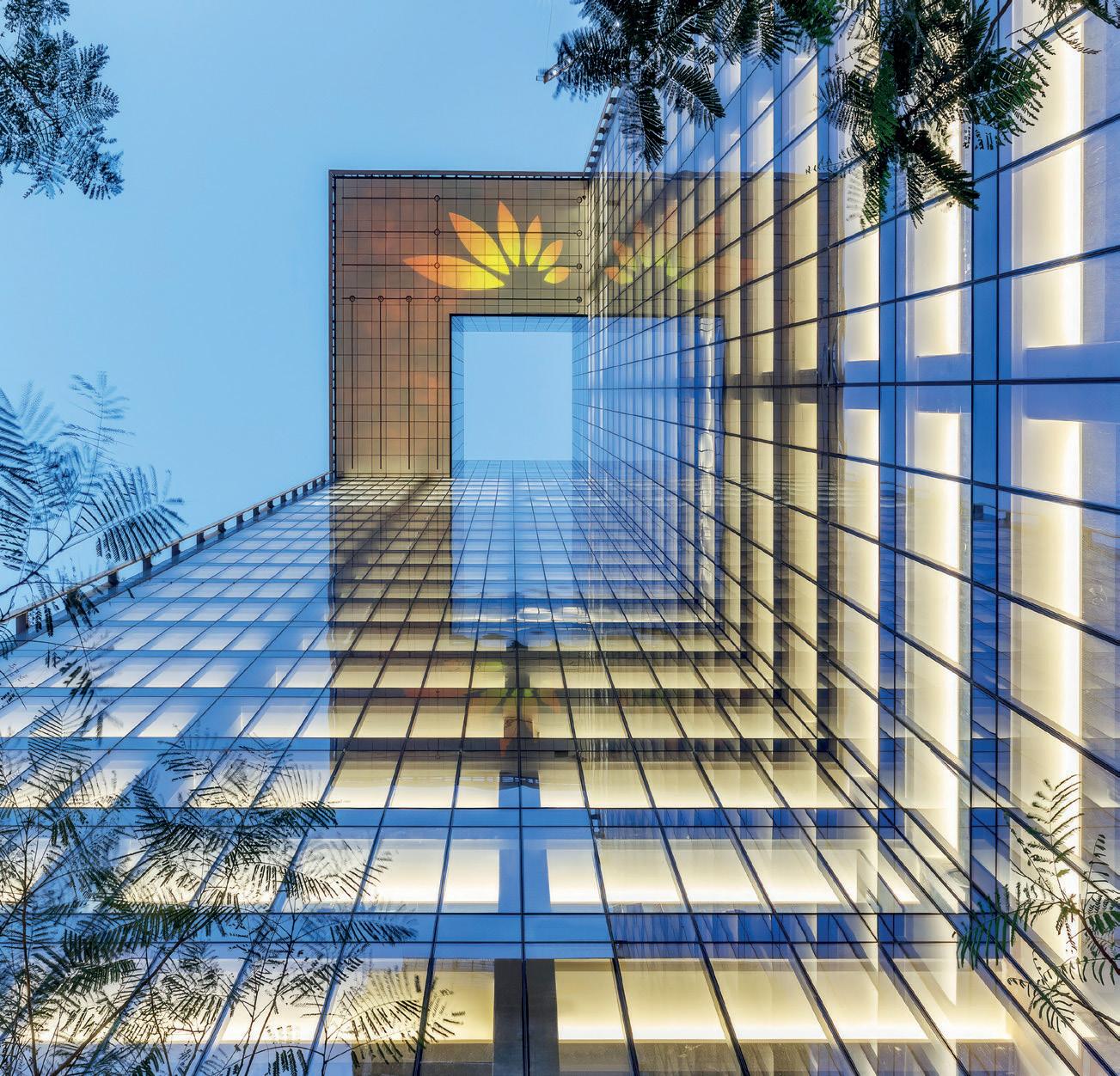
At present, the buildings with LEED designation tend to be expensive and exclusive locations, occupied by wealthy tenants. When will we see sustainable structures of this kind being available for a wider demographic?
“LEED buildings are not inherently more expensive than standard buildings throughout their lifecycle. One common misconception arises from the disconnection between construction and operations in certain regions. In our experience with LEED Gold Buildings, we have found that many of them achieve a return on investment of less than 5 years for most projects. By fostering collaboration among designers, operators, developers, and the supply chain, LEED buildings can be costneutral when approached intelligently.”
In Cairo, the Forbes International Tower will be the world’s first skyscraper using LOHC technology. To what extent do you believe we will see this technology emerging as a popular option in the quest for sustainability?
“Technology is the key to sustainable buildings, enabling innovative solutions to enhance energy efficiency, reduce carbon emissions, and optimise resource usage. Smart technologies, IoT devices, and data analytics allow real-time monitoring and control of energy systems, lighting, and HVAC, ensuring optimal performance. Advanced building materials and construction techniques improve insulation and promote eco-friendly designs. Renewable energy technologies like solar panels and wind turbines enable on-site energy generation. Energy storage systems help store excess energy for later use. Technology empowers sustainable building practices by providing data-driven insights, promoting automation, and unlocking possibilities for a greener and more resilient built environment. 90% of the technology required to deliver net zero
meconstructionnews.com July-August 2023
In the pursuit of net-zero energy buildings and collaborative design, the most energyefficient structures of the future will undoubtedly emerge through the ingenious guidance of AI-led programmes”
buildings already exist. We must now find a roadmap for investment and commitment to this technology.”
What are the main challenges and obstacles preventing more widespread client interest in commissioning energy-efficient projects? Is cost still the main impediment?
“The crux of the matter lies in the bottom line, which will continue to drive all construction endeavours until regulatory measures or carbon taxes come into play. In their pursuit, real estate buyers and investors are bound by market prices for buildings. At JLL, we steadfastly ensure that sustainable
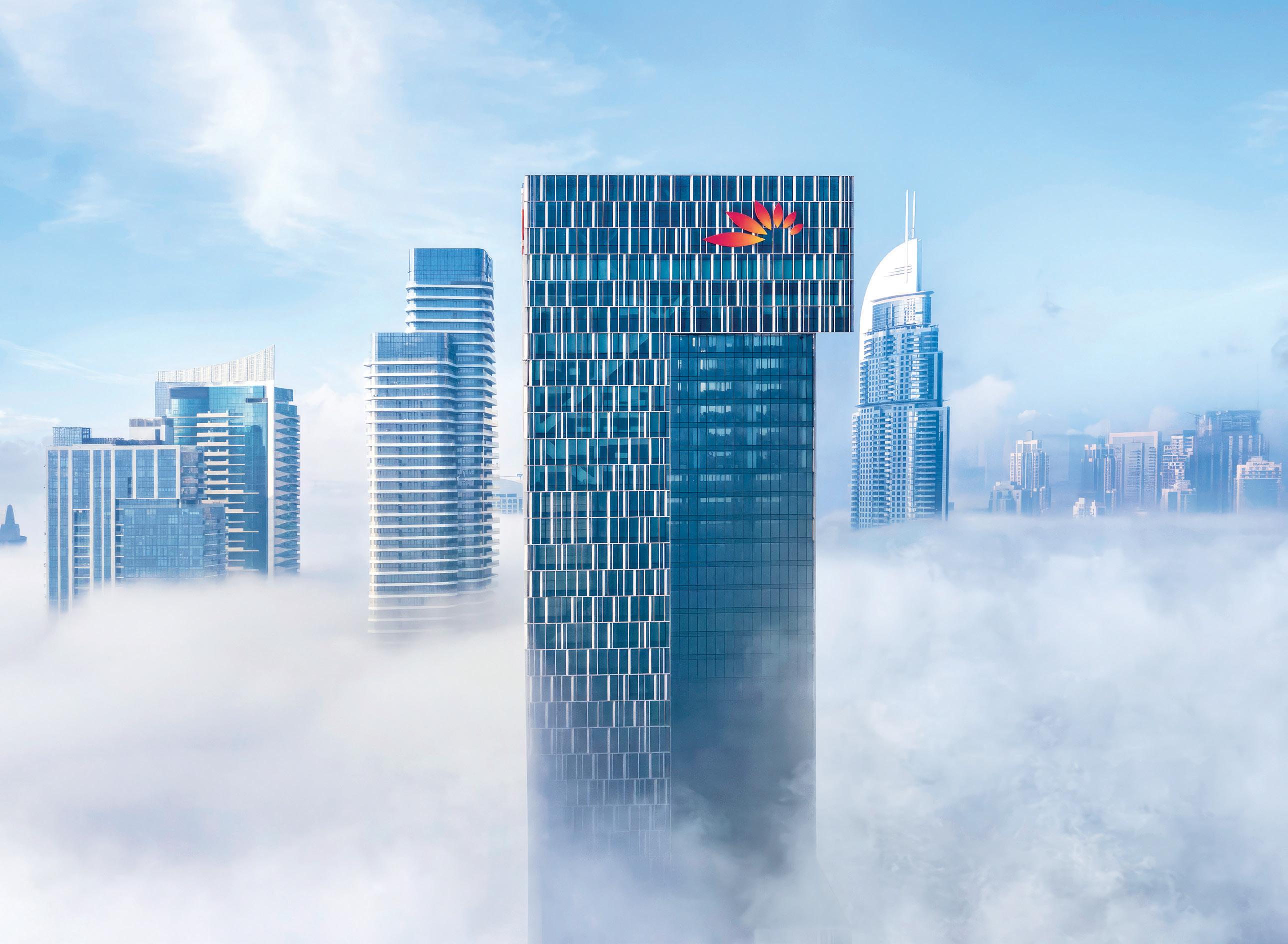
solutions are incorporated into our designs across multiple layers, from effortlessly integrated designs with no cost escalation to capital investments that promise tangible returns and even smaller investment segments that harmonise with their overall sustainability initiatives, social well-being, and marketing strategies. Yet, the crucial aspect is adopting a holistic approach that delivers a triumphant outcome for everyone involved. Furthermore, we emphasise the potential for higher rents and valuations, reaping long-term rewards as a result.”
Will the most energy-efficient buildings of the future best be designed by AI-led programmes (since these can equate and balance the many thousands of factors influencing net zero)?
“In the pursuit of net-zero energy buildings and collaborative design, the most energyefficient structures of the future will
undoubtedly emerge through the ingenious guidance of AI-led programmes. Thanks to unprecedented advancements in artificial intelligence and machine learning, these cutting-edge systems possess a remarkable capacity to analyse vast troves of data, optimise intricate design parameters, and conceive groundbreaking solutions that might elude human designers. By embracing the power of AI, we can unlock the full potential of sustainable architecture and engineering, resulting in buildings that not only achieve net-zero energy consumption but also minimise waste and seamlessly harmonize with their surroundings like never before.
“There is a quote I particularly like:
“The future of architecture hinges on the harmonious synergy between human creativity and AI-driven ingenuity, propelling us towards a more sustainable and environmentally responsible world”Smith, A. & Johnson, B. (2022)”
July-August 2023 meconstructionnews.com In Practice | 31
Mashreq Global Headquarters, Downtown Dubai, is the first commercial tower in MENA and the second building in the Middle East to achieve LEED Zero Energy certification.
ngi, what first attracted you to the Sustainability dialogue, and how did you initially establish a presence in what can - commercially - still be a challenging sector?
"Well, I have to say that it’s not so much a case of it “still” being a challenging sector but rather admit that the challenging nature of this sector does continuously persist and remains quite formidable, whether from a commercial attribute or particularly for women working within it - and that's something I'd like to delve into shortly.
But first, circling back to what initially attracted me to it, allow me to take you through the journey. I’m an architect by profession, by the way, and during my early studies, the term 'sustainability' would often be discussed by professors which got me curious about learning more about it and understanding its meaning. At the time, I was lucky to have been extended employment before graduation and that exposed me to bits and pieces of sustainability, such as the emerging LEED program that sparked numerous conversations. This ignited my curiosity even further, prompting me to explore this concept that everyone seemed to talk about, but no one fully comprehended nor provided me with a definitive answer. So, for me, it was like: ‘OK, what is this thing that I
keep hearing about? I need to know more’.
My turning point came when I had the opportunity to work on one of the projects within what was at the time the “first large-scale sustainable projects in the UAE”- MASDAR City. It led me to view architecture and sustainability from a fresh perspective: What if we look at it from an actual sustainable design point of view, going right back to first principles? I thought that if I want to do it, I want to do it right- and the moment I took that turn, I started working not just with the architects but with professionals from every other discipline, locally and abroad, the whole range of key stakeholders. Investigating material embodiments and innovative concepts. It was a game changer.
“You have to remember that during those early days, there was no precedent for any of what I was attempting to get into, let alone achieve. People would come to me looking for all the answers. By comparison, everyone has it easy now - you can even Google anything about sustainability and find lots of answers and discussions. There are lots of tools and information out there, people with knowledge and hands on experience, etc. But at the time it was quite a struggle: there were only a handful of people in the UAE that really had the specialised skills, interest and awareness”. Let me give you an example. When I used to go for a site visit, the construction manager would say: “Look, what are you checking for? If there’s waste, we can send it off and deal with it”. Just imagine – that was the understanding of sustainability back then: waste; like, where do you start from there, right? But just look at it now - it’s a whole different spectrum and a whole different game.
“The process has evolved to such a point where people are more aware and responsible, and the tools are now so advanced that sky’s the limit to what we can do. The time was right to make it right and that’s when I founded Climatize”.
At Climatize, we can offer a far broader grounding than a certificate, such as a better sustainability mix from a “performancebased, positive environmental and

meconstructionnews.com July-August 2023
32 | In Practice
At a time when so many companies are bolting on ‘sustainability’ skillsets and hoping to capitalise on the trend, it’s refreshing to meet someone whose entire calling has revolved around a fascination with sustainable values. Middle East Consultant spoke with Engi Jaber, CEO/Managing Director, Climatize Engineering Consultants…
“I want to do it right”
Engi Jaber, CEO/Managing Director, Climatize Engineering Consultants.


July-August 2023 meconstructionnews.com In Practice | 33
social impact perspective” which further complements on let’s say a Platinum certification and takes the project to a whole new sustainable dimension. I’m delighted, in fact, that many clients who opt for certification do come back and ask for the higher-grade work that we first suggested.
Now, let's talk about gender in this sector. Is being a woman still an issue? Well, the answer is both yes and no. Truth be told, it has come a long way in a positive direction but there is still more to be done.
In the past, encountering a female engineer on a construction site often raised eyebrows, with people questioning her presence and abilities, like: “What are you doing here?” “This isn’t your thing, surely?” Even today, I still encounter comments like, "How do you manage to handle everything? Did you obtain the necessary licenses, insurances and set up your bank account? Are you able to collect and pay dues?" It can be frustrating, but I maintain my composure, focused on getting the job done.
“So, the prejudice is still there, yes, but it often depends on who you are talking to, and it doesn’t necessarily reflect on the overall culture of the business. On the contrary to the negative bias, female engineers now receive more support and encouragement, are found in leadership positions and are seen as an inspiration in a
male-dominant industry. As a woman in this industry, earning the respect we deserve or being taken seriously isn't always a given. But we persist, continuously learning and evolving as we navigate this path."
Can you talk us through some of the ‘first steps’ you follow when a client’s brief tells you that they want to focus on Sustainability goals?
“I ask a simple question: what is your intent behind sustainability? If your goal is just to achieve certification, then that’s easily achievable for everyone now. But if you really want to make a difference to the whole community and stand out as a benchmark on the sustainability front, then that’s a completely different undertaking. Today, many clients are so sophisticated
(and we now see this happening across the whole of the GCC, particularly in Saudi) that we advise and discuss with them on taking on a highly evolved, bespoke approach to sustainability that aims on impactful performance-driven results.
“This means that, as consultants, we use a three-step strategy: we take on board what they are saying (i.e. their visions, requirements and budgets); then look around at the wider community and how it functions (i.e. special considerations and the value needed to be added, from an environmental and social point of view); and then we assess the development as a whole (i.e. what needs to be done, how to do it efficiently and further optimize it as much as possible, adding value to all).
“Of course, the role and intentions of the developer - even the most enlightened ones - are only half the story. The reality is that you can go for a Zero Energy building, but if the end-user doesn’t know how to operate the building, then it’s all for nothing. So, this is another aspect that we have to factor into the consultancy process; i.e. the sustainable asset management and end-user experience.”
Have you been involved in any of the LEED-certified projects in the UAE?
Yes indeed. We are involved in over 70 projects with a wide range of LEED and other certifications such as Estidama,

July-August 2023
34 | In Practice
The reality is that you can go for a Zero Energy building, but if the end-user doesn’t know how to operate the building, then it’s all for nothing”
WELL, Mostadam, etc. across the UAE, Saudi, Kuwait and other regions. Our LEED projects range across multiple systemsfrom Cities and Communities, New and Existing Buildings, Interior Design, and Homes.
To name a few, we are extensively involved in The Link at MASDAR City. It’s a 30,000 sq.m. community that includes the region’s first net zero energy shared living and working facility. It features a wide spectrum of low-carbon buildings that bring together event spaces, plazas, residential and retail. All its components are also LEED Platinum, WELL Gold, 4 Pearls PBRS Estidama and Parksmart Silver. One of the factors here is how do you balance the energy requirements of the residential tenants with the office users, because in areas of The Link you have them all together in one building. The way you would treat a resident need to be very different from how you would treat an office user, especially in terms of the kind of user expectations they will each have.

“Then, we are of course very proud of our work on the Living and Innovation Two project in DIFC, where we’re teamed with LWK + Partners. This is a truly spectacular and high-profile sustainable development, placing 200 residences in the heart of DIFC, and it’s currently going for LEED Platinum certification.

The Damac Lagoons, which is set to become the first LEED Cities and Communities Gold rated community in the UAE. A low carbon community featuring eco-friendly materials, energy efficientsolar powered infrastructure, green and blue communal spaces, 100% water savings via recycled and treated wastewater networks, smart waste management systems, biophilic design, biodiversity, agri- and aqua- farming, restorative spaces, wellness routes, facilities and activities
in addition to an on-demand e-fleet that connects and transports the residents across the development and the city are some of many more sustainable concepts executed in the project. Our work not only involved the sustainable masterplan design consultancy but also extended to cover two major buildings undergoing LEED Gold certification as well, the community club and sales center buildings.
In Saudi, we stand proud behind the Amaala Triple Bay Yacht Club, covering 7,900 sq. m. and set on four levels, the ultra-luxurious club is set to create a home from home for its members whether to do business, relax, entertain or take part in a calendar of yachting events. The entire Triple Bay development is targeting a minimum LEED Gold standard for environmental sustainability among many other high-end benchmark design targets.
I should add that there are also a range of giga-projects in Saudi that we are involved in, including over 10 unique
July-August 2023 meconstructionnews.com In Practice | 35
The Link at MASDAR City presents a plethora of opportunities for integrated sustainability, as well as the challenges of combining multiple and simultaneous usages.
masterplans that we’ve been engaged in from the planning stage down to the building designs, and a few other dispersed projects in the Kingdom that are under design and construction, but I can’t really comment on those because of the NDAs still in place.
In your opinion, how advanced is the new LOHC technology, that we’re going to see in Forbes International Tower in New Cairo, for example?
“Everybody is now talking hydrogen as the next big thing, and the technology has many supporters. Many clients are convinced that this is the way forward, particularly if they have a complete master-planned project in mind. But when we’re talking about energy applications in buildings, if I’m going to compare hydrogen sources with other forms of power, for me, there are some major question marks. For instance, if I compare hydrogen sources like-for-like with one panel of solar, the panel of solar is five or six times more efficient.
Of course, the LOHC technology is still on the rise and perhaps it can reach a point where experts in the field would encourage its applications in buildings with confidence. To me, any decision on which renewable source to consider should always be supported with life cycle assessments and a holistic analysis of what it entails and achieves.
“Now, while it’s true that we see a large commitment to hydrogen tech in sectors such as transport and logistics, there’s a huge difference between using these technologies for pure energy production or when you are modulating carbon emissions. When I talk on a building level, these technologies are not the same: there are other ways to decarbonise a building than talking purely about the need for energy production.
“There’s also another factor, too: we need to look at the actual materials, for example: what are their emissions? Are there any low carbon alternatives? are we going to be able to recycle these materials and to what extent are they sustainable? This is all part of effective governance and best practice.”
What research do you conduct in order to understand the local environmental factors that will be impacted by a major new project?
“Really, a simple answer: field work. We go out there, we check, and of course, as we calibrate and re-calibrate, there are lots of collaborations with the client. But let me add something here: whenever a client does conceive of a project it would really please me - please me to the bones in fact!if they actually went out there themselves, into the community and asked people what they think and what they actually want! A building doesn’t just serve itself - it has an impact on a whole social and community level. So, doesn’t it make sense to see what people actually want and need? I believe the commercial purpose needs to link with - and work with - the social front. So, when we at Climatize do our studies, they’re not just environmental studies, they’re also very much on the social front.
“There’s another factor, too. You also have to think of the experience within the building - we need to think in terms of the vertical city, the life and the interactions within the building for both the residents and business tenants - what is the quality of that lifestyle and does it really work? It’s not simply about the physical surroundings.
Engi believes that a project doesn't finish with its outline structure, but rather, it is important to consider the 'vertical city' within the building and the benefits and constraints it offers to residents.
“Moreover, the style of materials used also feed out into the community and will inevitably create a localised micro-climate. We are starting to hear a lot of talk these days about materials that may be stylish but create excessive heat fields and ‘hot spots’. These can interact with (and upset) the community; and remember, that the word “community” in this stance doesn’t just refer to humans – but the whole ecosystem, including plant, animal and bird life too.
“We believe in working closely with the client across all of these areas to establish exactly the right footprint, one that’s conducive for the community and delivers the most viable micro-climate.”
What projects can you highlight that you are particularly proud of working on?
“The Link at MASDAR City was one of our first zero energy projects and we are very proud of what was achieved there. Everything was rigorously tested and went through a whole parametric and technical modelling process. Very rarely do you get the opportunity to work from the earliest design stages, right the way through to the delivery of the whole building - and here, we were able to put our imprint on every aspect of the project’s conception and evolution.
“Of course, the way we engage on every project is different - there is no ‘one size fits all’ approach, and to be honest, I’m equally proud of everything we’ve worked on, but each for very different reasons. I wouldn’t want to bore you, but I’m sure that if we got out the project portfolio right now, I’d find some really satisfying angles about each and every project we’ve been privileged to work on - whether that’s some technical detail or the complete overview of the project and its final follow-through.”
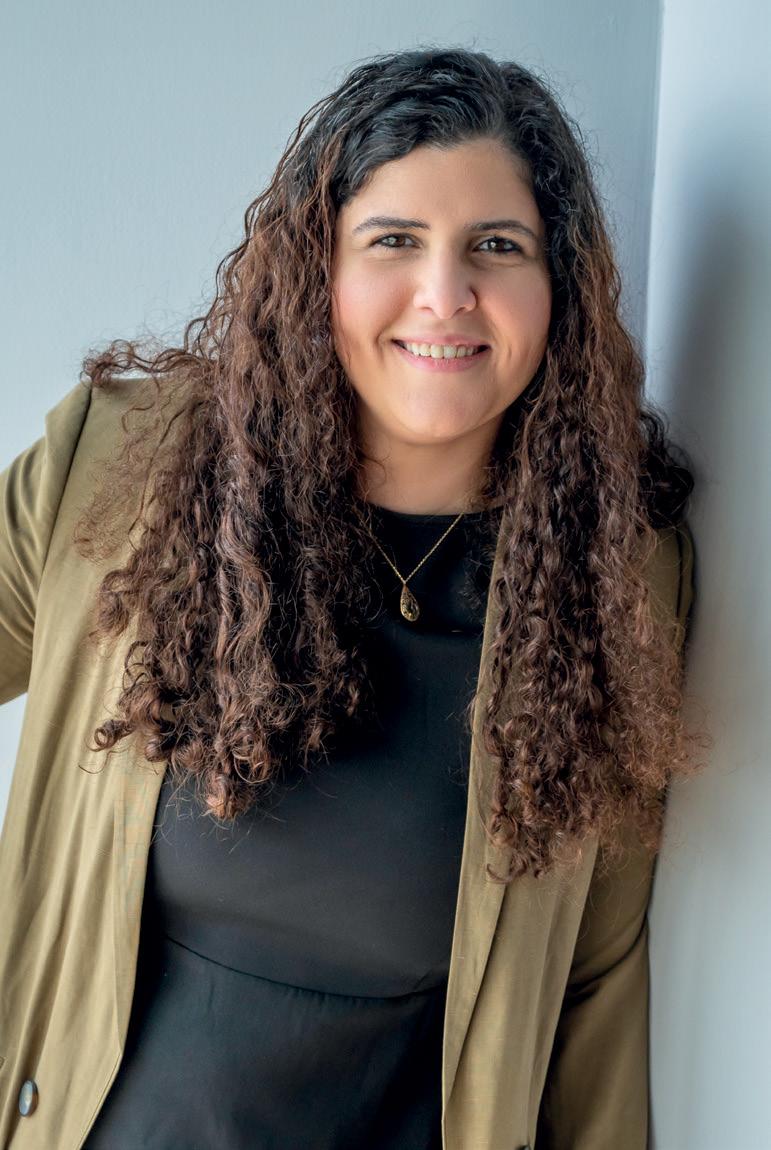
meconstructionnews.com July-August 2023 36 | In Practice


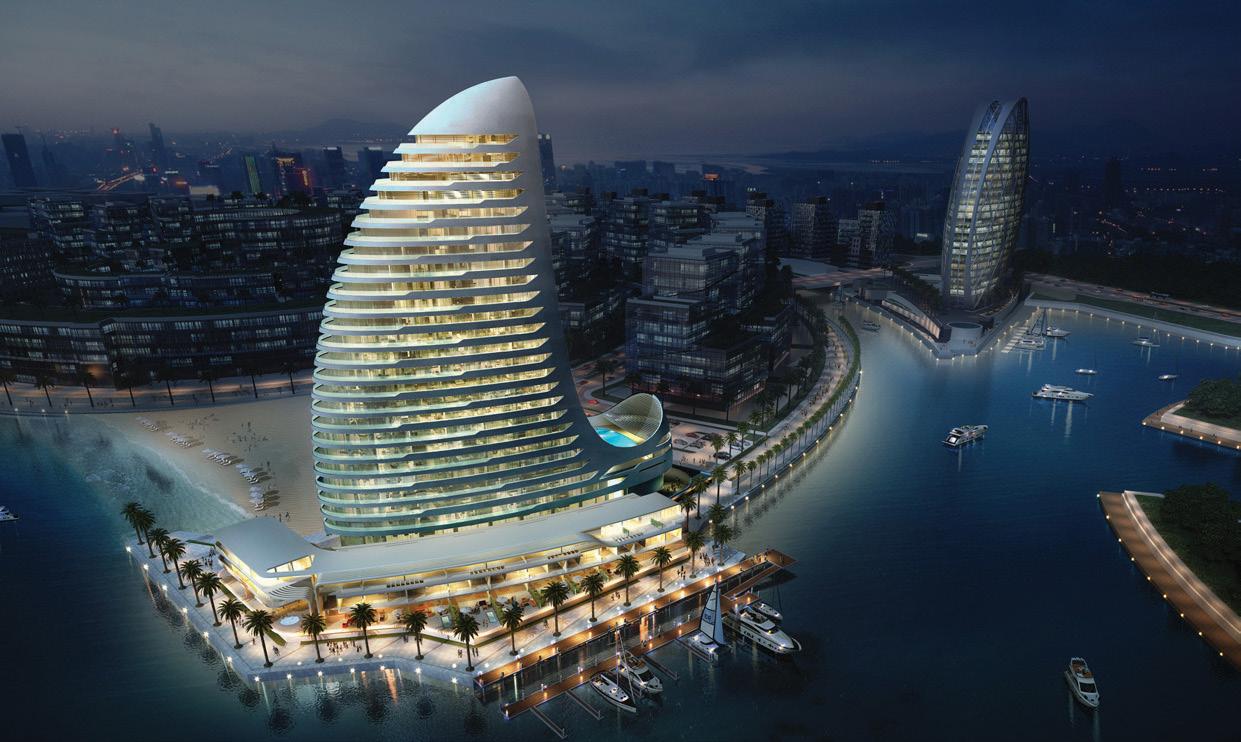

Residential Offices Commercial Mixed Use Hotels Public Educational Master Planning Sports & Leisure Religious Medical MZ Architects believes in pushing the boundaries of architecture and design to inspire and transform LEBANON KASLIK T +961 9 636 405 F +961 9 636 404 E info@mz-architects.com UAE ABU DHABI T +971 2 6350 002-1 F +971 2 6350 008-9 E infouae@mz-architects.com Our work relates to spatial concepts, form and structure 7th st. - Electra - Abu Dhabi, United Arab Emirates KBC Center - 5th Floor - Kaslik, Lebanon P.O. Box 159 Zouk Mikhael
BECOMING CYBER-SECURE
and effective for businesses and we work closely with our clients to ensure that our solutions meet their unique needs.
Would these cyber security solutions work across a complete project involving multiple stakeholders, or do they apply only to one entity at a time?
We understand that different companies have different security requirements, and different stakeholders have different metrics and risk appetites, however, whenever these different entities and stakeholders come together on a project, there tends to be common end business outcomes they are striving towards. We work with all stakeholders to be able to align cybersecurity controls and policies with these end business outcomes. By doing so, we can ensure that every players’ requirements and expectations are met from a cyber risk and protection perspective.
Response (MDR) solution is designed to provide 24/7 threat monitoring, detection, and response to small, medium, and large businesses. It leverages advanced analytics and machine learning to detect and respond to cyber threats quickly and effectively.

Are the systems completely clientcompatible, or do they require upload and buy-in from clients engaging with your business?
re the Port53 solutions suitable for any size of business, or are they designed specifically for the SME space?
At Port53, we offer a range of cybersecurity solutions that are designed to meet the needs of businesses of all sizes, from small and medium-sized enterprises (SMEs) to enterprise-level organisations. We understand that cybersecurity is a critical component of any business operation. Therefore, our solutions are cloud-delivered, easy to deploy, scalable, customisable, and cost-effective, making them ideal for organisations of all sizes. For example, our Managed Detection and
Our Managed Extended Detection and Response (Managed XDR) service is of particular interest to our clients. It provides 24/7 monitoring and rapid incident response as well as end-toend visibility and protection against cyber threats. With this powerful tool, SMEs can benefit from enterprisegrade cybersecurity protection without having to invest in the resources needed to manage their own cybersecurity operations. Our solutions can be deployed on-premise, in the cloud, or in hybrid environments, providing flexibility and scalability for businesses of all sizes. Overall, we are committed to providing cybersecurity solutions that are accessible
We always recommend that clients adopt a cohesive security stack and take a holistic approach to their security posture. Rather than follow a point solution buying strategy for controls that don't integrate well together, we recommend a unified approach to security, which is far more effective. When working with our clients, we collaborate closely to ensure that our solutions can seamlessly integrate into their existing IT infrastructure. We understand that each organisation has unique requirements therefore we customise our solutions to meet those needs.
meconstructionnews.com July-August 2023
38 | Security
In the quest to implement sound and comprehensive cybersecurity protocols, one of the key challenges businesses face is to pick systems that are designed and geared to the needs of their own scale of organisation, and which won’t require complex set-up or company down-time. Middle East Consultant speaks to leading cybersecurity entrepreneur and expert, Omar Zarabi, CEO and Founder of Port53…
The Managed Extended Detection and Response service is all about 24/7 monitoring and rapid incident detection.


July-August 2023 meconstructionnews.com Security | 39
Tell us more about the predictive culture that the systems encourage and how these can proactively reduce the raft of risks in your business?
In today’s cyber battlefield, it is critical to not only protect against the known threats, but also the unknown threats. Even within unknown threats, there is a subset that is known-unknown (we know that there likely are certain types of threats out there that we just haven’t identified yet), an another, more complicated unknownunknown category. These threats are threats that we as an industry haven’t even considered may exist tomorrow. It is critical to build a solution that is dynamic and adaptive by nature, quickly being able to identify any new potential threats against an environment, and adapting that environment to be able to defend against that new threat before ever engaging with it. With the coming of generative AIdriven attacks, this sort of proactive and predictive protection will soon become absolutely necessary.
What is the setup process? Does it require a break in current activities and how labour-intensive is it?
Because of the power of the cloud, many of our solutions can be deployed in our clients' environment remotely and within a day. However, we like to take a consultative approach with our clients, helping to assess each organisation’s existing security posture, identify potential vulnerabilities, and implement the necessary security controls to mitigate risks. The exact process can vary depending on the specific needs of each company, but we often start with an assessment of a client's current cybersecurity posture to identify potential weaknesses. This involves reviewing existing security policies and procedures, conducting penetration testing, and performing a risk analysis.
The next step is to create a tailored solution that is based on the results of the assessment and meets the client's specific needs and requirements. This may involve implementing new security
technologies, upgrading existing systems, and establishing new policies and procedures. Implementation comes next and involves working closely with the client to implement the necessary changes. This may involve configuring new security technologies, training employees on new policies and procedures, and conducting regular testing to ensure that the new security controls are effective. The final step involves ongoing monitoring which ensures that potential threats and issues are identified and addressed in a timely manner. In terms of the impact on current activities, the cybersecurity set-up process for Port53 clients typically does not require a significant break in operations. Our solutions can be implemented with ease and minimal disruption to client operations. We provide comprehensive support throughout the process to ensure a successful and smooth implementation.
What is the tie-in here with Big Data?
With the growing number of devices and systems connected to the internet, the amount of data generated by businesses is rapidly increasing. Big data plays an increasingly crucial role when it comes to

improving an organisation’s cybersecurity posture because, with the right tools and methodologies, it can help detect and prevent threats. Through big data analysis, we can identify potential security threats and vulnerabilities and figure out patterns and anomalies in the data. This guides the creation of predictive cyber security models that can alert businesses to potential attacks before they even occur.
For example, anomalies in network traffic can be indicative of a potential cyberattack or unusual behaviour patterns could signal a network breach. Big data enables us to monitor and detect threats in real time. This is particularly important as it can help with quick response times in the event of a cyberattack, potentially preventing or mitigating its impact.
While the system blocks attempted cyber break-ins, can it also show what attempts were made and where they came from?
A robust cybersecurity system not only blocks attempted cyber break-ins but also provides full visibility of traffic both on and off the network and comprehensive monitoring and reporting capabilities to help businesses understand their security framework so they can respond quickly and effectively to incidents. Our cybersecurity systems can show what cyber break-in attempts were made and where they originated from through various security tools and technologies that collect and analyse data through network security monitoring, intrusion detection and prevention systems, firewall logs, and more. As the #1 global Cisco partner, Port53’s cybersecurity systems leverage the power of the cloud to automate, safeguard, and predict customers’ security scenarios.
Does the installation of this system enable businesses to position themselves more favourably when they pitch for client work?
The installation of a cybersecurity system can certainly position businesses
meconstructionnews.com July-August 2023 40 | Security
Omar Zarabi, CEO and Founder of Port53.
more favourably when pitching for client work, especially in industries where data security is a significant concern. A strong cybersecurity system can demonstrate to potential clients that a business takes security seriously and has taken proactive steps to protect sensitive information. Having a robust cybersecurity system in place can also help to mitigate potential risks and vulnerabilities that could harm clients' data and reputation. Clients are likely to be more inclined to work with a business that can guarantee the protection of their data, as this can help to build trust and confidence in the partnership. With GRC (Governance, Risk and Compliance) being a top priority, companies are now moving away from compliance-driven approaches and towards cybersecurity frameworks that measure maturity. Compliance with a cybersecurity framework can give companies a competitive advantage and
showcase their commitment to security best practices and their ability to meet industry standards specifically when they bid for RFPs.

What ISO benchmarks and international best practice standards is Port53 aligned with?
I'm proud to say that we prioritise aligning with industry standards and best practices. We implement the ISO 27001 standard, which outlines the requirements for establishing, implementing, maintaining, and continuously improving an Information Security Management System (ISMS). We also utilise the NIST Cybersecurity Framework to help our clients identify, assess, and manage cybersecurity risks effectively. In the UAE, we help clients comply with the National Electronic Security Authority (NESA) framework, while in KSA, we work with clients to
align with the Saudi Arabian Monetary Authority (SAMA) and Communications and Information Technology Commission (CITC) frameworks for cybersecurity compliance. Our clients benefit from our extensive experience in implementing these frameworks and many more, which help to ensure effective cybersecurity management and maintain their trust. At Port53, we provide our clients with cybersecurity management tools that make it easy for them to know where they are and where they want to be while giving them the tools to measure progress. Our tools enable clients to report their cybersecurity posture to their management effectively and ensure compliance with the relevant standards and frameworks. We believe that aligning with industry standards and best practices is crucial for effective cybersecurity management and maintaining the trust of our clients.
Security | 41 WE ARE ISO 37301:2021 ACCREDITED @kingspaninsulationme @kingspaninsulationme Kingspan Insulation www.kingspan.com/ae/en info@kingspaninsulation.ae



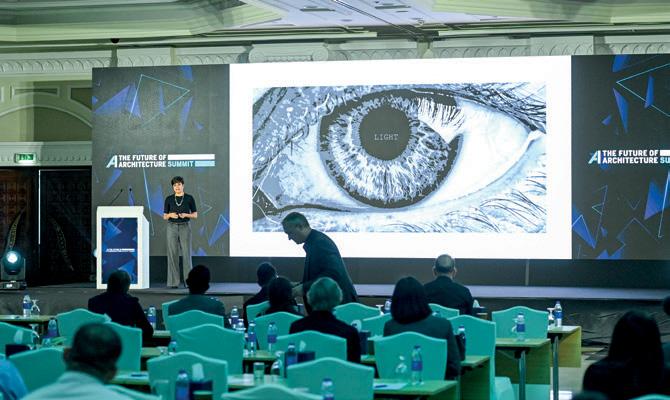



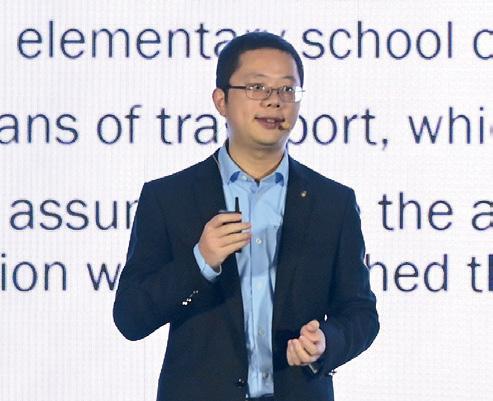

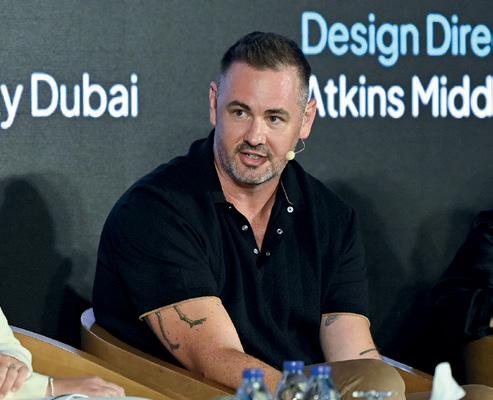




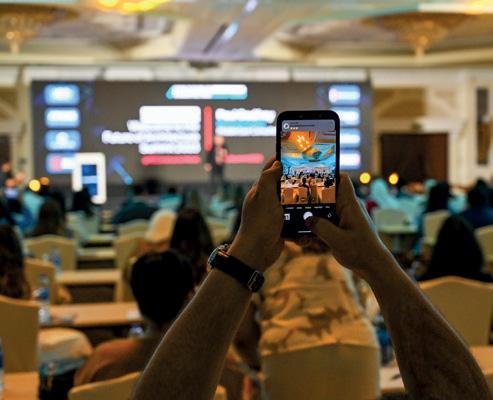


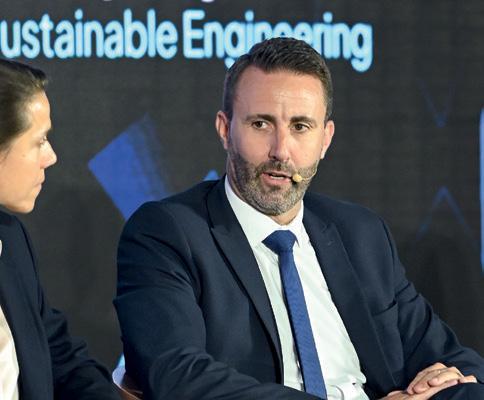


July-August 2023 meconstructionnews.com 42 | Summit
What will the Future look like?
At the Habtoor Grand Resort on 14th June, the Future of Architecture Summit set out to answer some big, compelling questions - and had some surprising conclusions…



• Is the future all about going supertall, or will it favour the ‘15-minute community’, built to low and mid-rise proportions?
• Is the new generation of generative software - such as Midjourney and DALL-E - going to squeeze architects and designers out of the picture altogether once it is used comprehensively by multi-disciplinary engineering firms?
he content and themes of the ‘Future of Architecture Summit’ derived from a number of key conversations with leading architects and civil engineers. They had raised several provocative issues and concerns, often in the pages of Middle East Consultant magazine. There were really three discussions that stood out, and it was these that became the core threads for the Summit. They were:
• Are we soon going to see the use of newera, bio-engineered organic matter used as building materials?
To answer these questions, the event brought together an unprecedented line-up of experts and architectural champions. The day started with a fascinating, overview presentation by Christian Vasquez, Architect and Business Development Executive, NEB, and Director, American
Institute of Architects, Middle East. Titled ‘The Future of World Architecture’, it asked what are the key design trends that we see emerging from the world’s major capitals and from the think-tanks of the leading architectural showcases? What are the new directions and to what extent they will translate into models for urban planning and the development of a new generation of ‘uber-communities’? In fact, this presentation was set to be quite prophetic, in that it argued strongly in favour of a future ‘hybrid’ model, where the virtues of building high (in order to reduce urban population density) were combined with the quickness and convenience of regionalised hubs, where all amenities can be accessed quickly - albeit only after proper consideration of road, infrastructure and mass transport options. This made-for-purposed urban plan should
July-August 2023 meconstructionnews.com
Summit | 43
ORGANISED BY SUPPORTING PARTNER SUPPORTING PARTNER PRESENTED BY SUPPORTING PARTNER ational ngineering ureau A c h t e c u a & E n g n e e n g C o n u a n SUPPORTING PARTNER BRONZE SPONSOR SUPPORTING PARTNER
then become the ‘holy grail’ of leadingedge architects, since it would be built to reflect and encourage real human needs, rather than impose a particular school of architectural thought.
One of the ways that this can translate into actual practice is by the proper and sensitive integration of new developments into an existing urban fabric, with a view to modernising them and improving living accommodation, access and personal mobility. These were the factors that the next talk focused on, presented by Li Ren, Project Architect at Perkins Eastman, with a highly visual and factual presentation titled ‘Sustainable Streetscapes in the 15-minute city’. He showed compellingly how a new and very ambitious development became part of an old, long-established urban community in Washington DC. While remaining super-faithful to established sidewalks and access routes, it contributed a new, highly sustainable series of options that were also visually very appealing and wellaligned to the previous well-known (and well-loved) cityscape.
THE INFRASTRUCTURE BEHIND THE DREAM
Yet, what about the actual infrastructure
that supports the new-style community and enables and empowers the choices and lifestyles that architects are seeking to deliver? Adam Smith, Managing Director, Polypipe Middle East gave a fasicnatingf series of insights into the infrastructure planning process in his presentation: ‘Creating a vibrant, healthy and highperformance infrastructure’.
He argued that while effective utilities planning is a vital function of the successful community, all too often, corners are cut and the optimum solutions not appliedwhether through lack of budget, shortage of know-how, or value engineering. Adam then explored some critical solutions that dramatically improve the utilities infrastructure, how it is planned and how it is most effectively actioned and delivered. Partly drawing on examples provided by the work, products and operations of his own company, Polypipe, he explained how to meet standards of best practice and support the expectations of community and urban planners alike.
He then went on to Moderate the day’s first panel discussion, called ‘What will the Future look like and why?’. The panelists for this session were:


• Laura Morgan, Market Intelligence lead MEA, JLL
• Sam Graham, Managing Director, RLB (Middle East)
• Dr. Harpreet Seth, Head of Architecture, Heriot-Watt University Dubai

• Engi Jabr, Managing Director, Climatize
• Manisha Dayaram, Chief Commercial Officer, The Devmark Group


• Edward McIntosh, Design Director, Middle East, Atkins


This extremely strong line-up of specialists debated how, despite a resurgence in the preference for super-tall structuresas seen most recently in SE Asia - the fact is that this style of building is simply too expensive to become the norm. Plus, in any case, the people who live in super-tall structures tend to be the super-wealthy, not the urban dispossessed, so there is no way that skyscrapers of this type can be said to relieve population density. Rather, the latest development models point towards a hybrid model, that is community-centric (as first discussed by Christian Vasquez and Li Ren).
How will those be physically built? Does the new trend for ‘re-purposing’ have a dominant future role here? The panel thought this unlikely. While new experiments with ‘re-purposing’ existing structures have had some success, this is not necessarily the best, most affordable and most sustainable route for all types of
July-August 2023 meconstructionnews.com
44 | Summit
urban planning and re-modelling. The fact is, there is no ‘one way’ at present, and we are likely to see the hybrid model proceed in a fairly ad hoc way for the forseeable future.
If we are so occupied with visions of the future, what about architects’ power to determine their own future? In his presentation ‘How should architects promote their vision?’, Alan George, Senior Architect, Orange Design Group, explored how best to deploy the raft of social media options and generate first-class followers, achieving scale and quality. This was a fascinating, 10-minute influencer briefing - and vital viewing!
IS AI THE DEATH-KNOLL FOR ARCHITECTS?
On, then, to the day’s second theme: are we about to witness the demise of specialist architects, because the power of AI-led, generative software is allowing everyone to become their own designer?
Dr. Bhakti More, Chairperson , School of Design & Architecture, Manipal Academy of Higher Education, posed the question in her presentation, ‘Artificial Intelligence - Architect of the Future?’
Dr. Bhakti showed comprehensively that these packages can indeed deliver multi-faceted, purposeful projects and that
it may not be long before we have to think of design as the product of a code rather than an intellectual, human mind. First to go will be the round of ‘cookie-cutter’ jobs at a junior level (note: the kind of role that many architectural firms have in abundance) and we are indeed likely to see something of a transformation of the sector in the near future. Dr. Bhakti’s presentation really shone in terms of the sheer level of hard evidence she provided of the ability of these packages - and indeed, of some of their present limitations and shortcomings.

BUT IS THERE STILL ROOM FOR DESIGN GENIUS?
In fact, the themes raise din Dr. Bhakti’s talk were of course the perfect introduction for the day;s next panel session, titled: ‘In the age of Smart tech, is there room for design and project genius?’
Moderated by Paul Godfrey, Head of Content, Middle East Consultant, the panel featured:

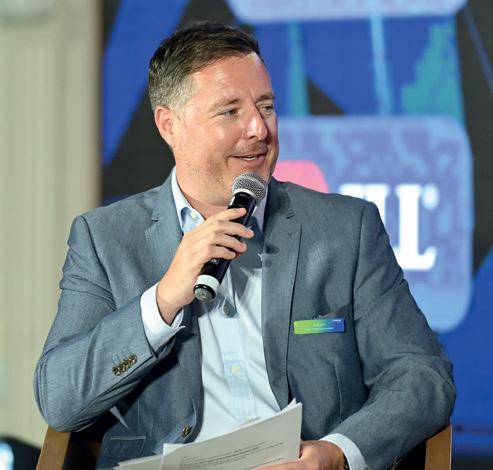






• Fernando Freitas, Director, Omnium
• Seb Davies, Director, RLB (Middle East)
• Preeti Mogali, Senior Associate, Perkins Eastman
• Dipali Shirsat, Founder, The Visual Poetry
• Nicholas Byczynski, Director of
Sustainable Engineering, AESG

• Barbora Pazderova, Founder & Global Director, Emeis Global
One of the principle areas of discussion here was that there’s a strong commercial dimension to the use of the new-era, generative packages, because they mean in effect that architects can be replaced with far greater cost-effectiveness. There is a good deal of evidence to show that this is indeed already happening - and there was also general agreement between panelists that we are soon likely to see the demise of junior-level architects’ jobs. While there was, however, also a feeling that the positions ‘at the top’ might be immune for some time, Paul Godfrey made the comparison with how early PCs required the operator to manually set the commands for leading and kerning - until all this was literally swept away by the advent of Steve Jobs and PCs with a smart user interface. At the same time, whole industriessuch as draftsmanship and typesettingdisappeared almost overnight. Wouldn’t it be the same scenario with architects?
In a final call for opinions, the panel’s consensus was that there was no more than a decade left before the tide of AI-led change would dramatically transition the architectural profession forever.
July-August 2023 meconstructionnews.com Summit | 45
As if to prove the point, Prof. George Katodrytis, Professor of Architecture, American University of Sharjah, then gave a highly sophisticated presentation showing exactly what these new packages are capable of creating - right now. His talk, which was called ‘Towards a new world order: what is the typography of structure that the new materials are capable of creating?’, showed that the advent of a new generation of materials doesn’t only mean higher levels of sustainability and new organic capabilities. It also means the ability to design in totally different ways and use new structural techniques - such as advanced 3D printing - to exceptional levels.

IS THE FUTURE AN ORGANIC PLACE?


Then the event turned to the day;s third theme – the use of new, advanced, highly sustainable building materials and the quest for fully organic solutions. Noone better-placed to comment here than Delvene Lee, Head of Interior Design, KEO International Consultants, who had recently written an outstanding article for Middle East Consultant magazine. In a beguiling talk called ‘What is the Future made of?’, she explained how we are at an exceptional junction in materials sourcing




and procurement where - for the first time in history - we can potentially move beyond traditional materials to a new dimension of full sustainability. We can even now think about materials that are organic in compound - extruded from the DNA of fungi and plants and able, like living entities, to place valuable oxygen into the environment. This major sea-change opens up hitherto unimaginable possibilities - and in some cases, examples of these applications already exist, setting exciting and fresh new benchmarks. What about, though, at least for the time being, maximising speed of construction through advanced modular solutions that also set new benchmarks in terms of pure sustainability? Accordingly, Jens Otterstedt, General Manager, Al Masaood Bergum, spoke about: ‘Modular construction: advantages and innovations’. In this presentation, he explained how Al Masaood Bergum is a regional leader in creating high-quality, fast-assembly modular components - often from dynamic new compounds and mixes of materials. He explained how this style of assembly works in practice and what are its structural properties and possibilities. Plus, he explained in depth how these factors best contribute to a sustainable approach to today’s built environment?
LIGHT - THE FOURTH DIMENSION
Powerfully providing the day’s anchor session, Maria Dautant , Senior Associate, HLB Lighting Design, explained ‘How lighting changes the vocabulary of the built environment’. In a presentation that was visually stunning, she explained how the current generation of interior and exterior architectural lighting is capable of radically shifting how we understand space and dimensions.
It can also be controlled and modified with minute precision, depending whether we want to preserve dark skies, light with intricacy, or with high intensity. The presentation looked at some of the technological advances in lighting and the architectural benefits that this can bring –in often dramatic and unexpected ways.
While the third session of the day - dedicated to the quest for hi-tech sustainables - had showed that in real terms, the science ‘isn’t quite there yet’, Maria’s presentation proved that, at least in terms of light and our present capabilities to work with it, we can unleash some very exciting interpretations of the present. Perhaps that in itself is a real key for understanding the Future of Architecture and what it will be like…

July-August 2023 meconstructionnews.com
46 | Summit


© 2023 CPI Trade Media. All rights reserved. Content Jason Saundalkar +971 4 375 5475 jason.s@cpitrademedia.com Paul Godfrey +971 55 472 9717 paul.godfrey@cpitrademedia.com Sponsorship Raz Islam +971 50 451 8213 raz.islam@cpitrademedia.com Andy Pitois +971 4 375 5473 andy.pitois@cpitrademedia.com Register now Scan here Riyadh, Saudi Arabia / 17 October 2023 Delivering a Vision – The Knowledge, Engineering, Technology and nuances transforming the Kingdom CONSTRUCTION INTEL SUMMIT KSA PRESENTED BY PRESENTED BY ORGANISED BY SUPPORTING PARTNER SILVER SPONSOR SUPPORTING PARTNER SUPPORTING PARTNER SUPPORTING PARTNER SUPPORTING PARTNER constructionintelsummit.com

meconstructionnews.com July-August 2023 48 | In Practice
ARCHITECT VERSUS AI: WHO IS THE WINNER?
AI IN PRACTICE
As disruptive as AI seems, the use of Generative AI tools in the AECO field to assist in different tasks and at different stages is not new. We have been using some form of them for several years now mostly known as data-driven or generative design. However, with the sudden increase in accessibility and capability, interest in AI and machine learning is growing exponentially as people simultaneously realise the enormous potential and also, the associated risks.
In our research, we have identified and explored close to 90 current AI tools applicable to the AECO industry and that number is only set to grow. These tools can be categorised into various groups, including image generation, adaptation, and ideation; presentations; write-ups and text generation and analysis; productivity enhancement; photogrammetry and reality capture; space planning at micro and macro levels; energy simulations, performance analysis, and energy efficiency; automation for repetitive tasks and workflow interoperability; augmented reality applications; image and video recognition and detection; health and safety tools; and facility management and operations solutions.
n the ever-evolving world of design, where innovation and creativity reign supreme, a powerful force has emerged to reshape the way we approach and execute projects. Artificial Intelligence (AI), once confined to the realms of

science fiction, has now become an integral part of the design process, revolutionising the field, and opening up new realms of possibilities.
The intersection of AI and design has given birth to a paradigm shift, enabling architects and engineers to harness the immense potential of machine learning algorithms. From architecture and engineering to construction and operations, AI-led design tools are swiftly gaining ground, empowering practitioners to push boundaries, optimise efficiency, and unlock unprecedented levels of creativity.
To fully realise the benefits of AI tools in architecture, we must consider the data used, specifically the Large Language Models (LLMs), which are utilised for analysis, creation, simulation, or automation. Currently, the use of Generic LLMs is prevalent, assisting with general inquiries. However, it is anticipated that in the near future, AECO technology providers will develop Specialised LLMs specifically tailored for design and construction purposes.
A significant challenge associated with these specialised language models is the availability of limited data for training. To overcome this challenge, AECO companies can take control by developing their own Custom-made LLMs. These specialized models can be designed to answer specific questions based on
July-August 2023 meconstructionnews.com In Practice | 49
The new era of AI-led generative software has already led to a number of alarm bells sounding when it comes to the working future of architects and the gravity of the role they will henceforward be able to play. Here, two senior figures from KEO International Consultants, Juan Tena Florez, Digital Services Director, and Haitham Mousa, Studio Design Director evaluate the changes and make some powerful future powerful predictions…
diverse historical data sources within their organisations. By creating their own LLMs, AECO companies can ensure that the AI tools are fine-tuned to their specific needs, incorporating domainspecific knowledge, and capturing the nuances of the architectural and construction processes as well as their unique “house style”.
As the field progresses, it is essential for AECO technology providers and companies to invest in data collection, curation, and customisation to build robust and specialized LLMs. At KEO, we are not standing idle. Our spirit of innovation has led us to start our AI journey, exploring a number of proof of concepts including a custom LLM tool allowing us to “chat” and interact with our own information. This will enable our architects, engineers, and construction professionals to leverage the power of AI tools that are precisely tailored to their requirements, driving innovation, efficiency, and informed decisionmaking throughout the architectural and construction lifecycle.
AI tools are finding applications across various stages of the asset lifecycle, providing assistance from early planning and ideation to operations and maintenance. However, the majority that we have identified are related to the initial phases of design and planning, where most decisions are made in a shorter time and can make a bigger impact in the design process, improving the overall quality and performance of the end product.
Generative AI's ability to rapidly generate content and speed up decisionmaking processes brings several benefits to the creative industry -

• Speed: AI tools can analyse large amounts of data quickly, providing insights and recommendations in a fraction of the time it would take a human expert.
• Scalability: AI tools can be easily scaled to handle larger volumes of data and complex problems, making them suitable for a wide range of industries and applications.
• Consistency: AI tools can consistently apply rules and criteria, leading to more reliable and consistent decision-making processes.
• Adaptability: AI tools can learn from experience and adjust their models and algorithms over time, leading to continuous improvement in decisionmaking accuracy.
• Reducing human bias: By using algorithms and data-driven models, AI tools can reduce the impact of human biases and errors in the decision-making process.
ARCHITECTS UNDER THREAT?
Having established the undeniable benefits of AI technology in the AECO industry, revolutionising processing capabilities at an unprecedented pace and creating new opportunities for creativity and optimisation that were once unimaginable but are now freely available, we have to ask ourselves; how are architects and architecture being impacted and ultimately is AI poised to replace architects altogether?
To answer this question, we need to look deeply at the architect’s process. When approaching a project, architects at KEO follow a methodical process. They delve into every aspect, starting from the project's location, environment, physical and social context, infrastructure, space programme and end users. In essence, they consider the social, physical, and natural surroundings in relation to the city. This is where AI's first layer of participation comes into play: data collection. AI is an incredible tool to research pre-existing information. However, each architect processes this information differently, based on their background, knowledge, and experience. They bring their own unique perspectives and interpretations to the data, which AI cannot assist with. This phase involves deep understanding of culture, emotions, and context, establishing the design drivers.
In the next phase, AI's participation is limited. Architects individually sort
meconstructionnews.com July-August 2023
50 | In Practice
Haitham Mousa, Studio Design Director, KEO International Consultants.
With the sudden increase in accessibility and capability, interest in AI and machine learning is growing exponentially as people simultaneously realise the enormous potential and also, the associated risks”
and organise the previously collected input according to their own methods, approaches, principles, and priorities. It's a highly human and individual act, influenced by personal perspectives and the nature of projects. These factors are interconnected and interlinked in diverse ways. This is why the initial phase is crucial; any missing factor can affect the final results and all factors contribute to defining the architectural product. It involves observing problems, limitations, and challenges, and transforming them into opportunities. This process relies heavily on intuition and subjective judgment.
Once these opportunities are defined, AI becomes an invaluable instrument for exploring new realms of creativity and finding connections. This is where AI shines and designers cannot match its potential, for processing large amounts of data and generating unlimited combinations and results. However, though the results of this phase may appear rich, the most fundamental aspect is again the filter of the architect, ensuring the product is following their intentions, and objectives. It is the architect's responsibility to define the identity, character, and values of the architectural element. They determine how the building will behave, interact, communicate, and integrate with its surrounding like an organism within the natural context.
This three-phase process not only defines the essence of an architect's work in terms of consistency and originality but also shows areas where AI will play a significant role, finding its place in the architectural process.
It is clear we are entering a new era in architecture, where the integration of AI technology is revolutionising the field, augmenting the capabilities of architects, and enabling them to push the boundaries of creativity and innovation. Collaboration between both parties creates a symbiotic relationship that enhances the quality of architectural design and will contribute to the better development of our cities. However, it is important to recognise
the limitations of AI and the irreplaceable insights and subjective judgment offered by human architects. While AI excels with data collection, exploration, and ideation, it lacks the ability to fully understand cultural, emotional, and contextual nuances. Architects bring invaluable expertise in navigating complex social and environmental factors. Implementing AI tools must be guided by ethical and sustainable practices to avoid overlooking critical human and environmental factors.
AI should be seen as a complementary tool, not a replacement, with architects retaining their role as the stewards of architectural identity, character, and values; balancing the power of AI with their nuanced expertise and intuition. Architects have social and tangible responsibilities towards the communities and the built environment.
Ultimately, in the ongoing debate between architects and AI, the true winners will be the individuals and companies that demonstrate the ability to adapt quickly to the changing landscape. As AI technology continues to advance and reshape the architectural field, those who embrace its potential and integrate it seamlessly into their workflows will gain a competitive edge.
Architects who are open to leveraging AI as a powerful tool, rather than perceiving it as a threat, can harness its capabilities to enhance their design processes, streamline workflows, and explore new creative possibilities. Likewise, companies that are quick to recognise the value of AI in architecture and invest in its development and implementation will position themselves as leaders in the industry.
The winners in the Architect v AI debate will be those who embrace AI as a transformative tool, adapt swiftly to its advancements, and find the optimal balance between human expertise and the computational power of AI. By doing so, they will unlock new opportunities, drive innovation, and ultimately deliver exceptional architectural solutions that meet the evolving needs of the communities they serve.

July-August 2023 meconstructionnews.com In Practice | 51
Juan Tena Florez, Digital Services Director, KEO International Consultants.
AI should be seen as a complementary tool, not a replacement, with architects retaining their role as the stewards of architectural identity, character, and values; balancing the power of AI with their nuanced expertise and intuition”

meconstructionnews.com July-August 2023 52 | On Site
UAE AND SPAIN: PARTNERS IN SUSTAINABILITY
Industry
he recent super-boom in Dubai’s real estate sector - particularly for uber properties on Palm Jumeirah and Jumeirah Bay - has resulted in some interesting new product opportunities for interior designers. While we may be familiar with some of the more exotic marble and hard-wood options, and their use for large-scale atriums, for example, there has also been a steep rise in the popularity of ceramic tiling and a broader acknowledgement of its decorative appeal.

To prove the point, let’s look at the economics. In 2021, the UAE imported ceramic tiles valued at approximately USD 316m USD (figures from the International Trade Centre). Spain has been one of the principal benefactors of this trade; the nation renowned for its innovative ceramic tile industry is playing a pivotal role in meeting the UAE’s demand. As the leading ceramic tile exporter globally, Spain achieved exports worth €2.1bn in 2021. Leveraging its position as one of the largest tile producers, Spain has embraced cutting-edge technologies like inkjet printing, laser ablation, and air

July-August 2023 meconstructionnews.com On Site | 53
4.0 innovations are redefining procurement choices - and Spain’s tiling industry is proving a vibrant and creative option, offering high-tech solutions, customised uniqueness and a powerful commitment to sustainability. In this feature unique to Middle East Consultant, Alberto Echavarria, Secretary General of ASCER, explains the growth in this not-quite-so-traditional sector…
is appropriate to
Tiling
multiple interior design options and brings fresh serviceability with great hygiene.
cleansing tile manufacturing. In 2023, the sector continues to spearhead change by embracing the Industry 4.0 revolution.
Industry 4.0, as we all know, is centred around data, and consumers are reaping the benefits. Data plays a vital role in controlling the design, thickness, and performance of tiles during the manufacturing process.
Architects and designers in the UAE can leverage digital design processes to achieve precision and explore a wider range of design options. Plus, advanced additives are also incorporated to enhance the functionality of the tiles. All these advancements are made possible through the adoption of Industry 4.0 capabilities, bringing more design choices and versatility into the market.
TRACEABILITY ENSURES QUALITY AND CUSTOMISATION
Industry 4.0 also brings traceability to the UAE ceramic tile market, enabling consumers to trace the origin of their tiles back to the source. This is crucial because tiles are produced in batches, each with slight variations. If a wrong batch is received that does not match the desired colour scheme or finish, replacing it becomes easier with Industry 4.0 technology. By leveraging data, consumers can trace their tiles to the source and order the exact set of batches, minimising the time and cost of replacing ceramic tiles and ensuring a pristine match first time.
SEAMLESS SUPPLY CHAIN MANAGEMENT FOR TIMELY DELIVERY
In the UAE ceramic tile industry, supply chain management is of utmost importance. Industry 4.0 has revolutionized the supply chain by utilising big data, digital warehousing, data collection, and tracking, resulting in a more seamless process. Data is captured throughout the supply chain, from raw material procurement to shipment to distributors and consumers. This data-driven approach enables informed decision-making on inventory management and ensures consistent ontime delivery to the UAE market. The streamlined warehouse management and
Alberto Echavarria, Secretary General of ASCER.

supply chain processes also contribute to reduced costs, which are ultimately passed on to the end-user, ie, the consumer.
SUSTAINABILITY AT THE CORE OF UAE CERAMIC TILE MANUFACTURING
The adoption of Industry 4.0 technologies in the Spanish ceramic tile industry has led to significantly reduced waste in the production cycle. In fact, it’s actually estimated that waste reduction measures have resulted in a 40% decrease in overall waste generated by the industry.
The UAE has always placed great importance on sustainability, and the Spanish ceramic tile sector is aligning well with these values. The hub of Spanish tile research and manufacture, the Castellon cluster, known for its high technology and performance standards, is driving innovative techniques in ceramic tile manufacturing, all with a focus on sustainability. The sector has achieved the first Environmental Product Declaration (DEP) type III label, indicating a commitment to developing sustainable ceramic tiles. Recycling initiatives are also prioritised, and Spanish tiles enjoy the lowest ‘life-cycle-cost-per-foot-for-floor’ finishes, as determined by the ScharfGodfrey study. Furthermore, Spanish tile manufacturers lead the way in bioclimatic architectural innovations, incorporating features like ventilated facades and active surfaces that reduce energy consumption.
REDUCING CARBON FOOTPRINT AND WATER CONSUMPTION
The Spanish ceramic tile sector is dedicated to reducing its carbon footprint and water consumption, and these efforts extend to the UAE market. Through Industry 4.0 technologies and innovative manufacturing practices, Spanish tile makers are actively bringing down both metrics. Water used in the production process is carefully re-used, contributing to a substantial reduction in water consumption. It is estimated that more than 95% of the water used in the manufacturing process is recycled, resulting in an average of 1.5 liters of water used per kilogram of ceramic tiles produced.
July-August 2023 meconstructionnews.com
54 | On Site
By leveraging data, consumers can trace their tiles to the source and order the exact set of batches, minimising the time and cost of replacing ceramic tiles and ensuring a pristine match first time”
Additionally, the sector has set ambitious goals to achieve net-zero carbon emissions by 2050 or indeed, even earlier.
The reality is that by leveraging datadriven processes, traceability, seamless supply chain management, and a sustainable approach, Spanish tiles offer UAE consumers a wide range of design choices, improved quality control, and environmentally friendly options. With ongoing advancements in technology and a commitment to innovation, Spanish tiles are set to transform the ceramic tile market in the UAE - and they’re all set to continue providing state-of-the-art products for years to come.

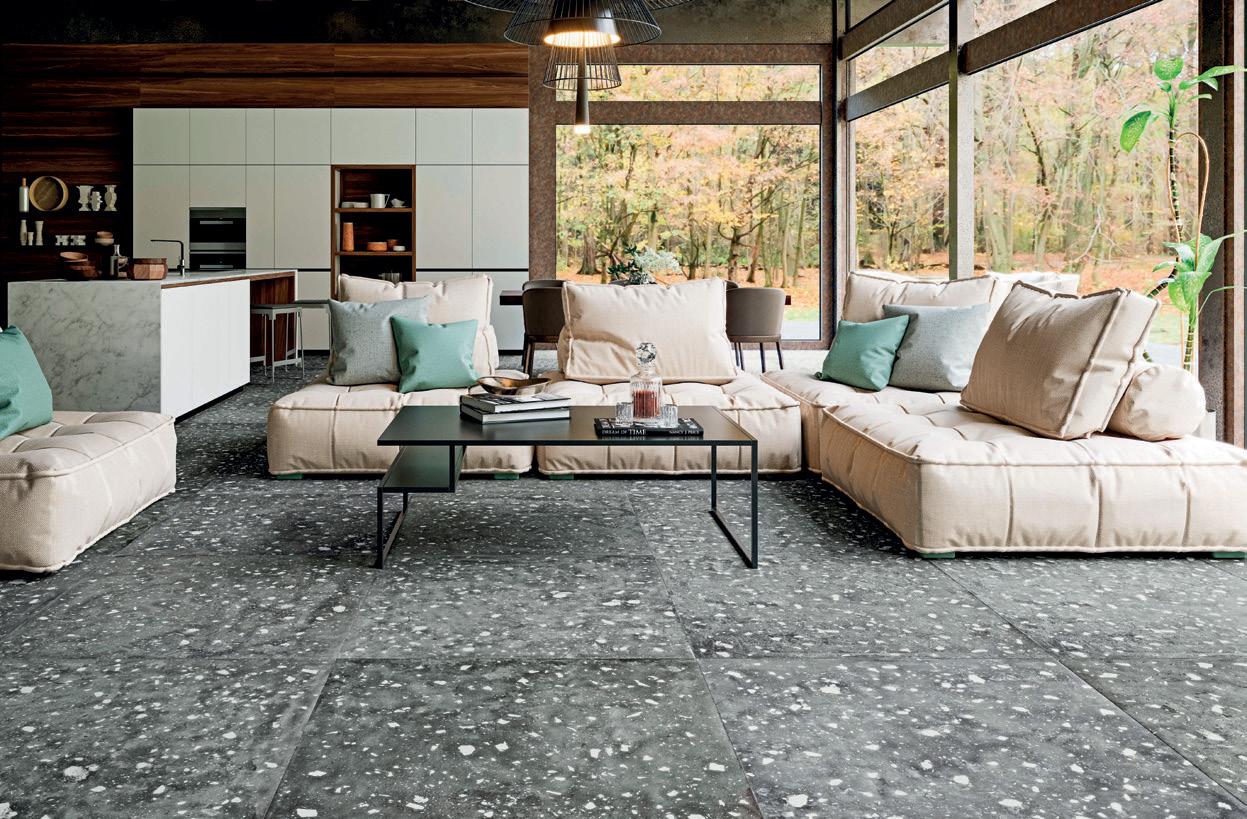

July-August 2023 meconstructionnews.com On Site | 55
Tiling combines centuriesold traditions with the latest developments in 'nano-technology'.

meconstructionnews.com July-August 2023 56 | On Site
CAN’T HEAR YOU!”
consistently vocal? A good example would be a telesales department or a group of client account handlers. It obviously won’t be a good idea to put these next to the legal team, or a group of creative design specialists who may well want a totally different style of working environment.
ith an increasing number of companies switching to open plan workspaces, it’s often forgotten that the advantages of an open spatial typology - greater communication between teams, ease of brainstorming, less ‘silo’ thinking, appropriacy for hybrid office/home working, etc. - are often accompanied by drawbacks. Perhaps the greatest of these is a higher level of ambient noise. Middle East Consultant spoke to international workspace experts Haiken about the most practical solutions for noise reduction and baffling.
First things first. For employees working in an office environment, a noisy workspace is more than just an annoyance. It can cause distractions, reduce productivity and even increase stress, not to mention the effects on employee morale and job satisfaction. In fact, research shows that employees working in noisy offices are actually more likely to leave their job within only six months of starting a new role. Meanwhile, a staggering 63 per cent of employees say they lack a quiet space for focused work, negatively impacting their productivity, fulfilment and well-beingwhich ultimately costs the business dear in terms of revenue, market share and staff attrition.
So - here are eight highly practical ways to reduce the noise in an open plan office.

1. PLAN YOUR WORK: REARRANGE THE OFFICE LAYOUT
In some cases, noise pollution can be managed with just a simple office rearrangement. Ask the following questions:
• Does one particular team need to be
• Is there any facility for quiet, private work? Even the most committed openplan evangelists acknowledge the need for ‘quiet booths’, which allow staff to get on top of extra work or ensure good privacy when working on new ideas, etc. The moral of the story here is that placing desks in clusters can help compartmentalise noise around the entire office. (Although, note that this doesn’t mean having clusters ‘for the sake of it’, which can easily undo the avoidance of the silo-thinking that open plan exists for in the first place).
Bear in mind that rearranging noisy office equipment can reduce distractions too. A simple method is to place the printer, photocopy machine, and so on, in a separate space, preferably surrounded by sound-proof baffles. This will help reduce the noise in the office, creating a more focused working environment.
When rearranging the office equipment, if it’s necessary to separate off a larger area, it’s a good idea to use dividers and screens. They can be placed around the areas dedicated to office machines, positioned on the floor, and even hung from the ceiling to help improve focus across the business and suit the mood of the intended workspace environment.
Then - what about the in-house café? It’s often forgotten that while an in-house café is a great way to add ambience and staff interaction, there are few places noisier and more guaranteed to cause complaints (think: the milk-frothing for cappuccinos and the coffee-grinding equipment!). So, this area can again be separated by movable dividers and baffles, ensuring that while it stays visually integrated and ‘part of the whole’, it can be self-contained, effectively subduing unwanted noise.
July-August 2023 meconstructionnews.com On Site | 57
One of the most important factors driving staff attrition in today’s market is employees being forced to work in an office where noise levels are too high. Particularly in open plan layouts, this can be a real problem, so how can it be combatted effectively, practically and - of course - affordably?
“I
Sound-proofed booths not only provide a great place to focus but add privacy in an open-plan setting.
2. APPLY THE ‘RULE OF FIVE’
Next, follow this important tip from the financial services and brokerage sector. Even in an open plan space, try to avoid ever having more than five people sit together in any one cluster - and even when there are groups of five, they should sit diagonally across from each other, never opposite. This is a powerful and proven way of combatting noise levels, while ensuring that small groups can also talk quite freely when necessary. The Rule of Five also
Adding dividers creates a clustered effect, which is great for confining sound and conversation.
ensures that no one group can raise noise levels to a point that contaminates the rest of the office and proves distracting. There are even specially-designed desks in an X-shape that ensure people sit diagonally across from one another, never opposite.
3. INTRODUCE PLANTS
Not only do plants look great, boost the well-being of employees, and improve air quality, but they help to reduce noise within a space, too. If you are working to a bigger budget, large, living - ‘biophiliac’ - walls can also be introduced to combat a noise problem, and have now become extremely popular in commercial design. Do remember, though, that these will need maintenance and upkeep, and with more sophisticated expanses of plant, it is far preferable to install practical and unobtrusive automatic watering systems than it is to have a team of plant maintenance workers coming into the office every week.
4. INSTALL ACOUSTIC PODS
Acoustic pods are self-contained spaces where employees can work, brainstorm, and fully concentrate away from their desks. Think of them as creating a private working area, free from any distractions. They’re easy to set up, move around and can accommodate all types of budgets. They also provide quiet spaces where members of staff can escape from the hustle and bustle of the open plan and ‘get themselves together’ productively.
The biggest and most obvious benefit that comes with acoustic pods, though, is their ability to block out (and contain) sound. Some acoustic pods can block out up to 100 per cent of noise, giving both the office pod user and wider workspace a quieter environment to concentrate in.
5. IMPLEMENT (SUSTAINABLE) ACOUSTIC WALL PANELS

Sound absorbing materials can be placed around a room to reduce inbound noise, making acoustic wall panels a great solution for combatting noisy, open plan offices. However, some may be quick to disregard this solution, because, typically, wall panels at the lower end of the market aren’t always visually pleasing. Alongside this, there are many wall panels in the market that claim to be sound absorbing, when the reality is, they aren't. So, it's

meconstructionnews.com July-August 2023
58 | On Site
always best to ask for proof of a sound test. Another factor to consider is that when choosing wall panels, it’s best to opt for those using largely sustainable materials in their construction. Also, consider colour palettes that fit in with existing suite decors and the company’s brand identity.

6. POSITION ACOUSTIC DESK DIVIDERS/WALL PARTITIONS
Similar to wall panels, acoustic dividers/ partitions are tried and tested solutions for blocking out noise, and they don’t only have to be used to segregate the café or a batch of noisy office equipment (as mentioned above).
Do remember, however, that these shouldn’t be used as a means of creating ‘temporary’ offices - you are using the open plan strategy for a reason, after all!
Partitions of this kind can also have architectural/interior design value; they are particularly effective when used creatively near the reception area, and placed so as to take visitors on an ambient ‘journey’ through the workspace.
7. EXPLORE YOUR FLOORING OPTIONS
Hard surfaces such as wood, ceramic and porcelain can be extremely unforgiving in noisy environments. If noise is a serious problem in the office, it’s advisable to try good-quality carpet, or a vinyl flooring solution - both are ideal for reducing noise in a workspace, particularly if the space follows a long, rectangular layout, where sounds can
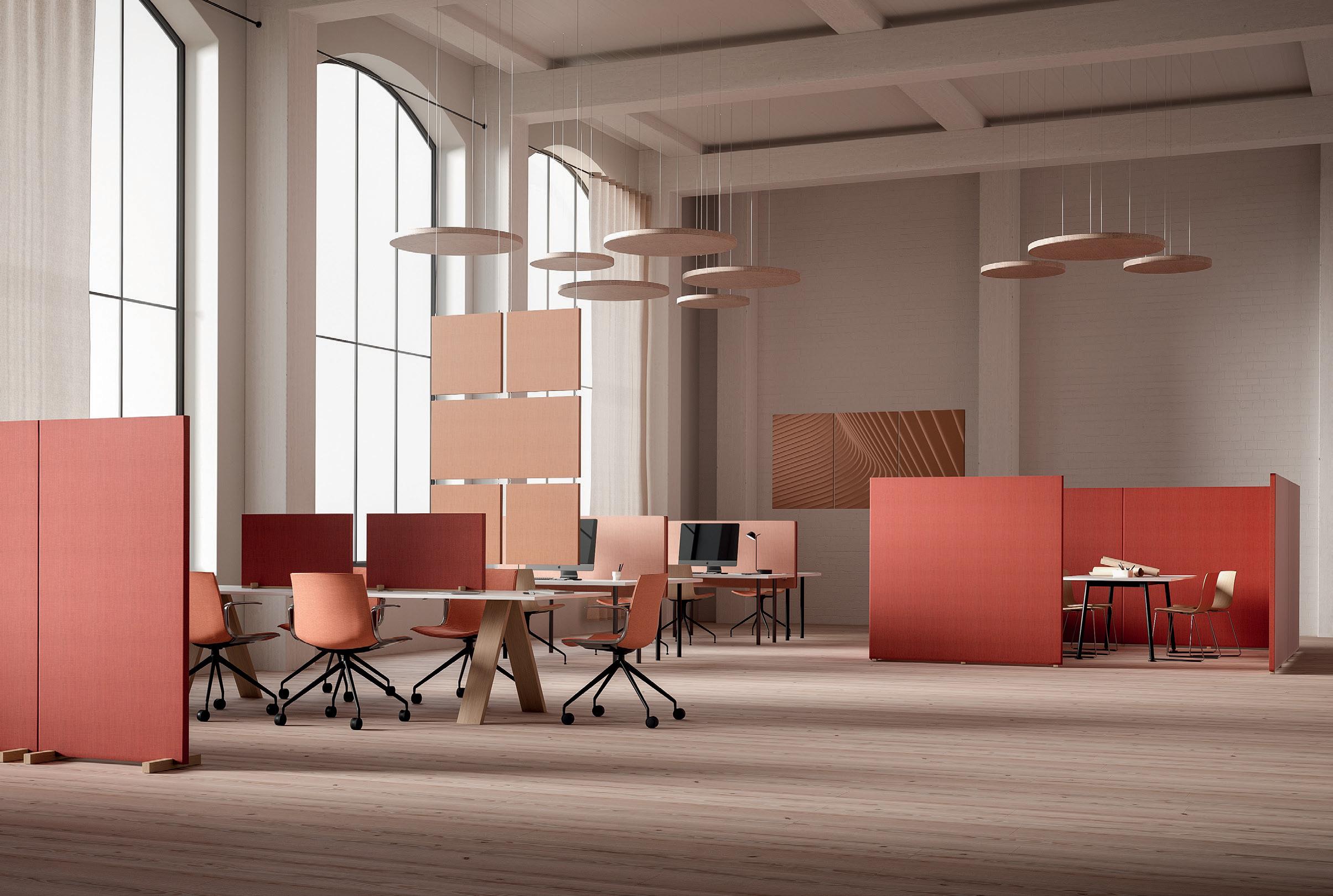
project up and down the length of the area. You can also choose the weave and colour of the carpets to reflect particular organisational interests - blue hues for a marine organisation, terracotta if there is a desert focus, and so on.
8. NOISE-CANCELLING HEADPHONES
Think of this solution as more of a ‘cheat’(and perhaps a last resort!). If re-designing the office isn’t a feasible option, or if the finance team require that you look for something super quick and cheap, then noise-cancelling headphones could be an ideal solution. You can buy a small, colour-coded batch and give them to any members of the team complaining about the ambient noise levels. Note that the colour-coding can also align with corporate branding, giving an inclusive, well thought-through vibe.
July-August 2023 meconstructionnews.com | 59
Relatively simple baffles can make a powerful difference to sound projection - and can look great too!
WHY GLASS? GETTING THE HEAT OUT OF THE CITY

meconstructionnews.com July-August 2023 60 | On Site
Glass was first widely used as the ‘de facto’ covering for window apertures in about 30BCE, in ancient Roman Egypt (the time of Cleopatra). While it has always been defined by its shortcomingsit’s fragile, costly, difficult to handle and install and heat-retentive - it has defied competitor materials to such an extent that, since the era of Mies van der Rohe and the creation of the ‘glass tower’ it has been used as the default material for the vast majority of skyscrapers worldwide. Yet now, in the era of heat-imaging and infra-red surveys, the quest is in on to find workable options that won’t create ‘heat hubs’, storing up the heat of the sun and projecting it straight back onto the communities below the building. Middle East Consultant spoke to Houston-based A&C Plastics, Inc. about some of today’s most expert options…


July-August 2023 meconstructionnews.com On Site | 61
IRST THINGS FIRST: WHAT TYPES OF PLASTIC CAN BE USED AS GLASS ALTERNATIVES FOR WINDOWS?

While our perception may be that glass is the optimal material for windows, alternative options in plastic have many advantages. There are a variety of plastic materials that can be used as glass window alternatives. Indeed, they are not only ‘alternatives’ but actually superior in many ways. We will look at two different plastics, acrylic/plexiglass and polycarbonate, to see how they compare with traditional window glass.
Firstly, Acrylic, also called plexiglass, is becoming a popular alternative to glass windows. While manufacturers
have used waterproof acrylic windows for years, plexiglass acrylic sheets are gaining traction among architects, developers, business owners and some residential homeowners. Its popularity is primarily due to the growing recognition of the numerous advantages of acrylic plastic over windows made of glass. For example, here are some of its key benefits:
Cheaper: Acrylic sheeting takes less energy and money to produce than its glass alternatives. Additionally, its lightweight properties allow transporters to ship the plastic at a lower cost. Cheaper production and transportation allow acrylic manufacturers to sell their product at a significantly lower price than glass. Ultimately, savings for the manufacturers add up to cost savings for business owners and consumers.
Stronger: Acrylic plastic sheets have 17 times the impact strength of traditional glass. It takes a lot more direct force to shatter plexiglass sheeting. If you live in a hurricane or tornado-prone region, plexiglass will perform far beyond any protection that traditional glass offers. Additionally, acrylic sheeting will significantly reduce the risk of a stranger being able to break into the home. (If a window does not break within a few seconds, statistics show that most burglars will give up their forcible entry attempts).
Safer: While clear plexiglass is strong, it can break with enough persistence or the right amount of force. However, unlike glass, acrylic plastic windows will not shatter into a thousand minuscule shards of sharp, dangerous slithers.
Easier to Use: Especially for an architectural project, glass is too brittle, rigid and heavy to use when creating unique, large-scale shapes and pieces. On the other hand, plexiglass is made up of flexible polymers that render it easier to move, cut and install. Acrylic windows are ideal glass alternatives when your project includes several large windows.
Better Light Transmission: Perhaps
surprisingly, clear acrylic sheets are more transparent than glass. In fact, clear acrylic sheets allow for more than 90% of light to pass through them! Furthermore, acrylic windows do not show glare and reflections. Unlike glass, acrylic does not become discoloured as the sheeting thickness increases, making it a perfect alternative to glass windows.
More Special Qualities: Acrylic sheeting is the most versatile type of plastic on the market. Numerous special types of acrylic can be manufactured to meet customised needs, including mirrored, colored and fluorescent, abrasionresistant, light-diffusing, anti-static, bullet-resistant, UV-filtering and many
July-August 2023 meconstructionnews.com
62 | On Site
In a culture perenially used to glass, it's easy to forget the decorative yet highly practical potential of polycarbonates.
more options. Acrylic has even been used to make glass block windows.
BUT - ACRYLIC DOES HAVE ONE PRIME DRAWBACK…
One caution here: for centuries, an accepted benefit with glass is that it has always offered exceptionally good interior insulation from heat or cold. Comparing density and thickness ‘pro rata’, it provides far better insulation like-for-like than plastic windows - so this needs to be considered in environments with strong summer heat or severe winter cold. This inherent lack of insulation can, however, be compensated for by using thick or multi-layered acrylic plastic glass.
THE NEW ERA: POLYCARBONATE WINDOWS


Due to the limitations of glass and acrylic sheeting when used in certain environments and demanding applications, polycarbonate sheeting was developed to meet the diverse needs of architects and developers looking for highly contemporary solutions. Not only super-tall towers subject to high windspeed and the dynamics of turbulence, but facilities like schools, bus shelters and psychiatric facilities benefit from a window material with high impact resistance, structural strength and design flexibility. Although more expensive, polycarbonate plastic windows are significantly superior to acrylic and glass windows. Here are some of the reasons why polycarbonate is et to be the structural choice of the future –250x Stronger Than Glass: Not only 250x stronger than glass, polycarbonate plastic windows are also 30x stronger than acrylic. Clear polycarbonate plastic has an incredible level of impact resistance, but it is also just as clear as glass. It provides a margin of safety that no other clear glazing material on the market can surpass.
Superior Structural Support: Compared to glass, polycarbonate sheets are lightweight, but they require less structural support than any other glass system. Glass and acrylic materials are structurally limited when faced with demanding architectural projects. However, polycarbonate plastic sheets succeed where many other plastic and non-plastic materials have failed. Variety of Grades: Clear polycarbonate sheets can be made to fit the performance requirement for any project. Certain branded variants can excel when used in glazing and industrial applications. They protect against accidental breakage and intentional vandalism.
Super-cool operation: certain types of polycarbonate are perfect for applications with exposure to extreme sunlight, such as fully glazed facades, high atriums,
July-August 2023 meconstructionnews.com On Site | 63
While manufacturers have used waterproof acrylic windows for years, plexiglass acrylic sheets are gaining traction among architects, developers, business owners and some residential homeowners”
covered walkways, thermoformed skylights, etc. Even under constant UVrays, this grade of polycarbonate will not become yellow, hazy or lose its levels of light transmission, making it an ideal plastic for windows.

Design Flexibility On-Site: Glass and acrylic materials require pre-forming and fabrication before installation. Polycarbonate sheeting can be cut or cold-formed on-site.
Speciality Sheets: Like acrylic, manufacturers make polycarbonate plastic into many different types of products with unique performance capabilities. Plastic manufacturers can make polycarbonate sheets that are: bulletproof, coloured, mirrored, tinted, anti-static, or abrasion-resistant.
Polycarbonate can also be effectively heatshielded without requiring any tinting at all - in the same way that heat-protective film on car windows is only tinted for the sake of appearance (the colour and its percentage does not actually play a role in the heat protection at all). These are all exceptional qualities when it comes to making choices for glazing deployed on premium properties, whether office or residential.
The fact is that acrylic and polycarbonate options to glass are not only alternatives, but are to be preferred in many settings and applications; and they can also play a key purpose in today’s quest for sustainability, since they dramatically reduce transport and handling costs, as well as labourintensiveness on-site. They can also be engineered to have energy-saving characteristics built in as a key priority, or can use compounds with low heat retention - thereby playing an important role in cooling down urban ‘hot-spots’. What now seems like an exotic option may well become tomorrow’s everyday norm, and play a key role in evolving and transforming the shapes and performance of urban design.
July-August 2023 meconstructionnews.com 64 | On Site
C M Y CM MY CY CMY K
One of the main uses of polycarbonate transparent sheeting is in large public sector and infrastructure settings.
since 1956

CELEBR AT E
A R CHI TECTU R A L i nno v a ti o n
A ST O UND I N G su cc es s

G LO B AL r ec o g n itio n
I N O VE R 2500+ P R O JE C T S
D E S IG N RE -I M A G IN E D
























































































































































